CONGRATS #ASUGRAD
Highlighting the excellence of recent alumni AI-POWERED MEDICINE
ASU researchers are improving human health

Sun Devil Men’s Swim and Dive team dominates the NCAA Championship — and Léon Marchand eyes Olympic gold
Volume 27 N umber 3 ARIZONA STATE UNIVERSITY
champs National

Contributors
Kyle Gilbert
His photography has earned recognition in the American Advertising Awards and Emmy Awards. His portfolio includes collaborations with Chosen Foods, Virgin Hotels and National Geographic.
Amit Katwala
An editor and writer at WIRED, he works on features, science and culture. His latest book is “Tremors in the Blood: Murder, Obsession and the Birth of the Lie Detector.”
Jennifer Kite-Powell
A senior technology contributor at Forbes.com, she was named one of the top 100 women in technology in Europe in 2012, and shortlisted for best tech journalist by the TechCrunch Europas Awards.
Jeff Newton
An editorial and commercial photographer, his clients include Google, adidas Originals, The New York Times, Sports Illustrated, Men’s Journal, Popular Science and Forbes.
Wendy Paris
A freelance journalist, she has contributed to The New York Times, Psychology Today, The Guardian and more.
Stephanie Vozza
A freelance writer who covers productivity, careers and leadership, she has written for Fast Company since 2014.
CHIEF BRAND OFFICER, PUBLISHER
Jill Andrews �97 BS, �03 MPA
MANAGING DIRECTOR, EDITOR
Lindsay Kinkade
MANAGING EDITOR
Kari Redfield
SENIOR ART DIRECTOR
Heidi Easudes DIRECTOR, ASU NEWS
Penny Walker
DEPARTMENT EDITOR, COPY EDITOR
Leigh Farr
PHOTO COORDINATOR
Sabira Madady
DESIGNERS
Erica Brooks, Candy Choi, Beatrice Guo, Laura Kryger �93 BFA, Mark Munoz, Raini-Skye Rogers
PRODUCTION
Chris Myers, Jason Puckett, Zachary Leitzke
If you would like to update your mailing address or switch to the digital version: news.asu.edu/content/subscribe
STORY IDEAS AND ADVERTISING INQUIRIES
asuthrive@asu.edu
ASU THRIVE MAGAZINE
PO Box 875011, Tempe AZ 85287-5011 602-543-5234
asuthrive@asu.edu
news.asu.edu/thrive-magazine
Celebrating commencement season
ASU graduates grow our national economy, strengthen our democracy and enhance our national security. All of these are tied together, and each depends on a robust pipeline of qualified, college-educated members of society. The Global Employability University Ranking and Survey recently ranked ASU as the No. 2 public university in the U.S. for the employability of its graduates, ahead of UCLA, University of Michigan and Purdue. This spring, ASU will send an estimated 20,300 graduates on to the next phase of their lives. Some will continue their scholarship and pursue advanced degrees. Many more will enter the American workforce, joining fellow ASU alumni already working at prestigious companies such as Intel, Banner Health, Deloitte, Honeywell and Apple.
These ASU grads will fill gaps in the workforce in critical fields, including health care, engineering and science. Some of them, along with the state of Arizona, have roles to play in the reshoring of American manufacturing of semiconductor chips. This will help advance a sustainable industry, create good, high-paying jobs, enhance America’s economic competitiveness, strengthen national security, and reduce the nation’s current reliance on Asia for production of leadingedge chips.
Other ASU graduates will go on to help chart the future of artificial intelligence – an area in which ASU leads as the first higher education institution to collaborate with OpenAI, the company behind ChatGPT. ASU graduates are employed worldwide, and more than one in four Arizonans who hold at least a bachelor’s degree are ASU alumni.

If you have supported a college graduate, financially or otherwise, thank you. No one reaches this milestone alone. If you see or celebrate a graduate this month, congratulate them on their achievement. And remember, it’s not just pomp and circumstance. It’s an investment in American prosperity.
Michael M. Crow
President, Arizona State University michaelcrow michaelmcrow asuprescrow presidentcrow
ASU Thrive (USPS 024-438; ISSN 1940-2929) is published quarterly by Arizona State University Enterprise Brand Strategy and Management, PO Box 875011, Tempe, AZ 85287-5011, 480-727-5440. Subscriptions are sent to all ASU alumni. For detailed information about supporting alumni traditions, scholarships and programs, visit alumni.asu.edu/give-back/donate Periodicals postage is paid at Tempe, Arizona, and additional mailing offices. Postmaster: Please send address changes to ASU Thrive, Attention: Circulation, PO Box 875011, Tempe, AZ 85287-5011. Permissions: Portions of this publication may be reprinted with the written permission and proper attribution by contacting the ASU Thrive editor. ASU T hrive can be accessed online at news.asu.edu/ thrive-magazine ASU Thrive is printed on paper that is certified to the Forest Stewardship Council® (FSC ®) Standards. ASU Thrive is paper neutral, replanting trees equivalent to paper usage in geographic areas of need.
official publication of Arizona State University Summer 2024, Vol. 27, No. 3
The
ASU THRIVE MAGAZINE 1 WELCOME COVER: MIA JONES/ASU
Events
Calendar of events
Upcoming event highlights on ASU’s campuses. Page 4
Research and news
Top 10 in the world for utility patents. Page 9
Building the U.S. microelectronics supply chain. Page 10

Career
5 easy ways to improve your focus
Research shows that sharpening your concentration boosts productivity and shrinks stress. Page 14
Lifelong learning opportunities. Page 17
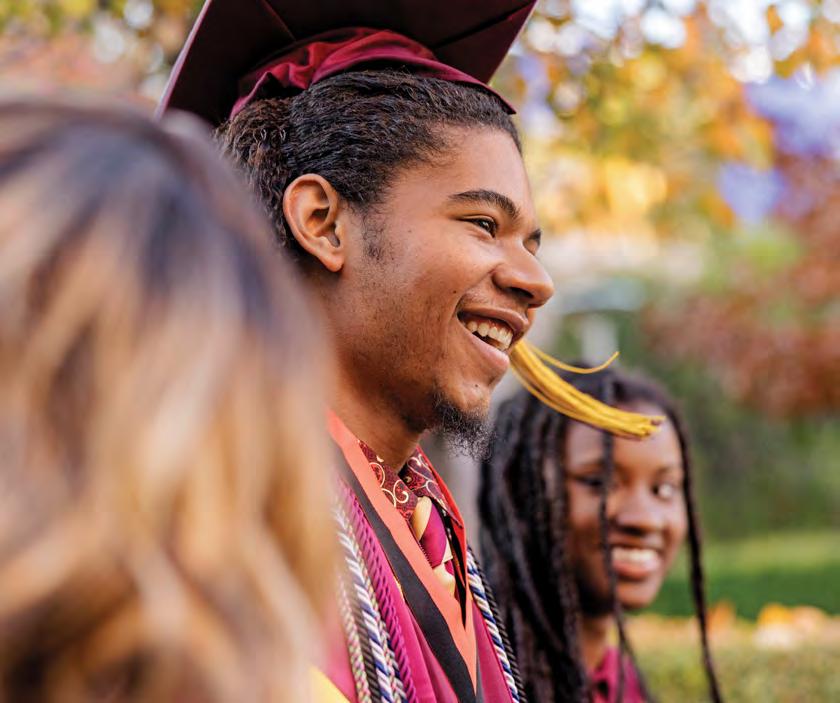
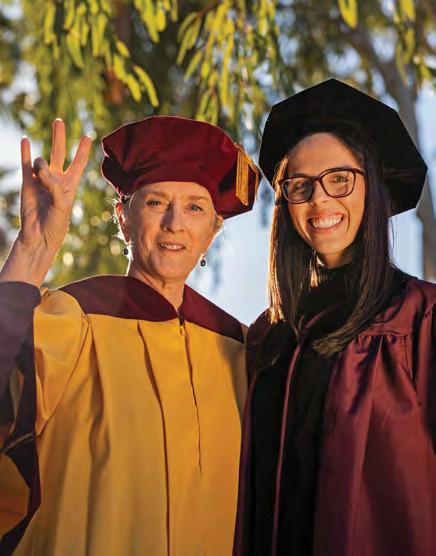
youtube.com/ASU youtube.com/ASUathletics
linkedin.com/school/Arizona-State-University linkedin.com/company/asualumni
Commence
Time capsule
From cherished campus memories to pop culture trends, here’s a look back on your ASU journey. Page 20
Worldwide impact
Catching up with elite scholars. Page 26
Golden grads return
Alumni celebrate the 50th anniversary of their commencement. Page 30
instagram.com/ArizonaStateUniversity instagram.com/ASU_alumni instagram.com/SunDevilAthletics
JILL RICHARDS; SABIRA MADADY/ASU
Dallas Salas,’24 BS in neuroscience.
Ruth McGregor, ’74 JD, and grandniece Jaci Cochrane, ’24 JD.
2 S UMMER 2024 FIND
Advance
AI -powered medicine
ASU researchers are using artificial intelligence to improve health. Page 34
First AI graduate business degree in the U.S. Page 42
The rise of a first-gen graduate at Intel
How Cindy Rogel Bahena blazed a trail with help from her mentors. Page 44
New engineering school at West Valley campus. Page 49
Intel grant supports personalized tutoring for engineering students. Page 50

analysis.
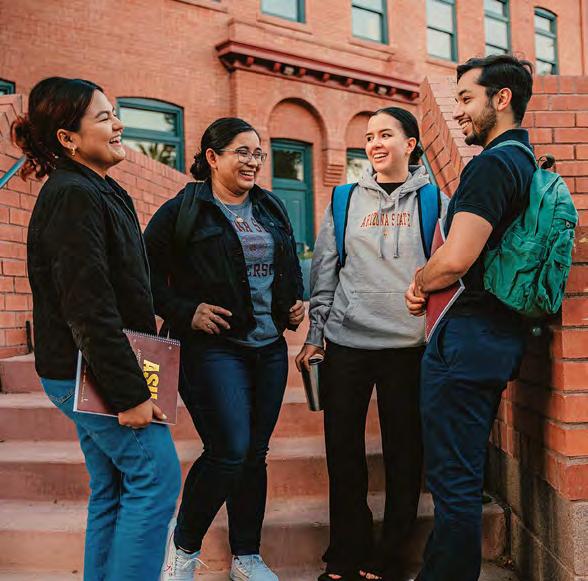
threads.net/@arizonastateuniversity threads.net/@asu_alumni
Arts Ticket to fashion
Phoenix ASU FIDM students road-trip to LA. Page 54
S ports
National champs: Sun Devil Men’s Swim and Dive team dominates the NCAA Championship — and Léon Marchand eyes Olympic gold. Page 60
Golfer’s 27-under win sets records. Page 63
Family
Golfing at the football field. Page 64
facebook.com/ArizonaStateUniversity
facebook.com/ASUalumni
facebook.com/ArizonaStateSunDevils
Digital extras and the latest updates
Please visit magazine.asu.edu for the digital magazine with embedded videos and links.
BOOK-OPEN magazine.asu.edu
p interest.com/ArizonaStateUniversity
JEFF NEWTON; TODD MACMILLAN
Jay Shah and other ASU researchers use AI for better MRI
Cindy Rogel Bahena (second from left), ’21 BSE in materials science and engineering, landed a job at Intel.
ASU THRIVE MAGAZINE 3
June

Juneteenth Celebration
Recognizing the impact of Black communities in Arizona, the Juneteenth Celebration offers an opportunity for visitors to connect with organizations representing historical societies, action groups, state resources and the community at large. Guests are welcome to wander, discuss and enjoy performances, activities and food.
Sunday, June 16, 10 a.m.–4 p.m., Arizona Heritage Center, 1300 N. College Ave., Tempe asuevents.asu.edu
Free Family
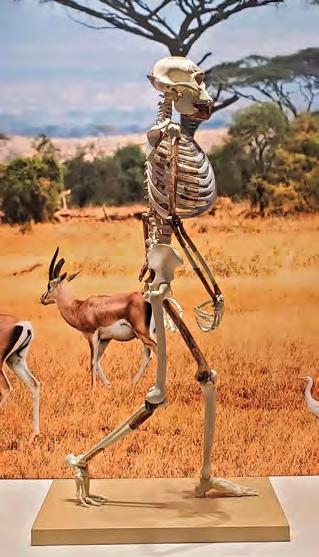
Lucy 50 Lecture Series 2024
In honor of the 50th anniversary of the discovery of the 3.18 million-year-old fossil skeleton, “Lucy,” the Institute of Human Origins is hosting a monthly master class illuminating humankind’s origins. Join Lucy discoverer Donald Johanson for “A Connection to the Natural World” to learn about our connection to our human past and our global future.
Friday, June 28
youtube.com/@ASUInstituteofHumanOrigins Free Family Online
Sun Devil Send-Offs
The ASU Alumni Association, Admission Services and ASU
Family invite incoming first-year students, their families and alumni to Sun Devil Send-Offs, a great opportunity to meet other students and families from your area. Check the link below for Send-Offs across the U.S.
Saturday, June 22–Thursday, July 25 alumni.asu.edu/sun-devil-send-offs
Free Family
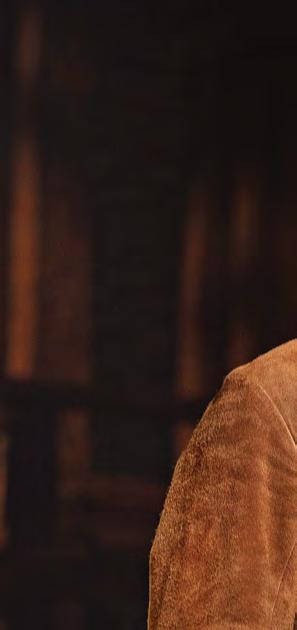
Pushing the boundaries of creativity
This summer, discover your inner poet through “The Crafting Connection” workshop series. With expert guidance from Ashanti Files and Kianah Brooks, take a deep dive into poetry techniques and explore the poetic craft. Writers of all levels of experience in all genres are welcomed and encouraged.
Wednesday, June 26, 6–7 p.m., Piper Writers House, Tempe campus piper.asu.edu
Free Family

Sun Devil Rewards has an updated look, new games and more rewards!
Found in the ASU Mobile App, play Sun Devil Sudoku, crosswords and other favorites for more of those shiny gold ’Forks. sundevilrewards. asu.edu
Rocks from space
This summer you can take your family to find out where meteorites hail from and where they have been discovered on Earth. You’ll learn how old meteorites can be (some have been dated at 4.56 billion years old) and what they’re made of. Founded in 1961, the Center for Meteorite Studies is one of ASU’s first-established research institutes and houses one of the world’s largest university-based meteorite collections.
Mondays through Fridays, 9 a.m.–5 p.m., Buseck Center for Meteorite Studies, ISTB4, 781 E. Terrace Road, Tempe meteorites.asu.edu
Free Family
4 S UMMER 2024 I NSTITUTE OF HUMAN ORIGINS/ASU EVENTS

Broadway’s ‘Hamilton’
A tale of passion, unstoppable ambition and the dawn of a new nation, “Hamilton” is the epic saga that follows the rise of Founding Father Alexander Hamilton as he fights for honor, love and a legacy that would shape the course of a nation. In addition to its 11 Tony Awards, “Hamilton” has won Grammy Awards, Olivier Awards, the Pulitzer Prize for Drama and a special citation from the Kennedy Center Honors.
Tuesday, June 25–Sunday, July 28, ASU Gammage asugammage.com
Family Ticketed
July
Dive-in movie: ‘Moana’
Join a poolside viewing of a journey across the ocean as Moana sails the high seas to save her people. This community event will feature a raffle giveaway. Food and drinks will be available for purchase. Register to attend.
Friday, July 26, 6:30–9:30 p.m., Sun Devil Fitness Complex Pool, West Valley campus asu.edu/west Free Family
Comedy @ Kerr
Laugh out loud as scribe and comedian Sari Beliak takes you on a hilarious and insightful storytelling journey. Phoenix-based Beliak is a former senior contributing writer for The Onion. She’s written for comedy sites like The Hard Times and Reductress and was a guest writer on NPR’s “Wait Wait...Don’t Tell Me!”
Wednesday, July 31, 7:30 p.m., ASU Kerr, 6110 N. Scottsdale Road asukerr.com
Ticketed
A night of unforgettable tales
Truths revealed or feelings spared? In the Gather Storytelling show, “Truth or Spare,” experience three true stories and a folktale, plug into the oral traditions of the past and present, then get the story behind the stories in the fan-favorite Q&A at the end of the show. Attend in person or view at youtube.com/asukerr after the show.
Thursday, Aug. 15, 7:30 p.m., ASU Kerr, 6110 N. Scottsdale Road asukerr.com
Ticketed
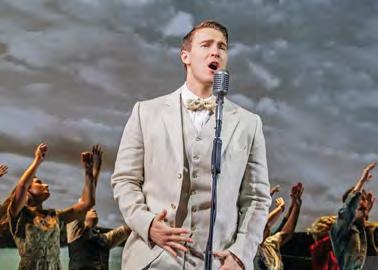
Bob Dylan’s songs reimagined
The Tony Award-winning musical “Girl From the North Country” reimagines 20 legendary songs of Bob Dylan as they’ve never been heard before. Set in 1934 in Duluth, Minnesota, this extraordinary production tells the story of a group of travelers whose lives intersect in a guesthouse filled with music, life and hope.
Tuesday, Aug. 20–Sunday, Aug. 25, ASU Gammage asugammage.com
Family Ticketed
Aug.
See asuevents. asu.edu for additional ASU events. Visit thesundevils. com for athletics.
ASU THRIVE MAGAZINE 5 J OAN MARCUS; EVAN ZIMMERMAN/MURPHYMADE
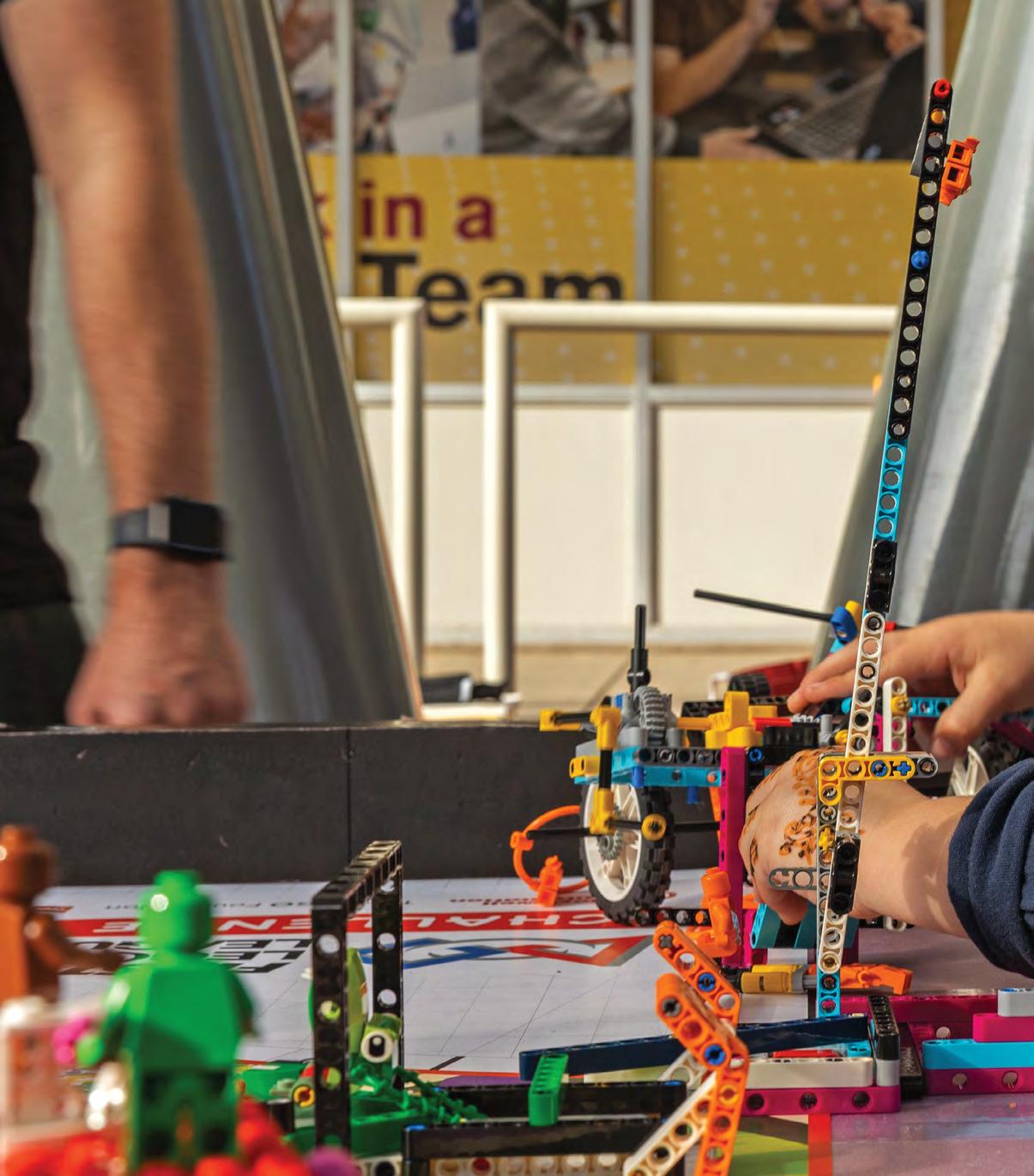
LEARNING EXPERIENCES
Making campuses and learning opportunities available to everyone
Each year, ASU Open Door invites the local community to experience the university and discover why it continues to be ranked No. 1. Open Door 2024 spanned four days and four campuses with hundreds of hands-on activities created by faculty, staff and students —one of many programs throughout the year for children of all ages. Visitors could plan their exploration by areas of interest, age group and location.
Activities ranged from robotics experiences to virtual reality games to hydroponic agriculture demos. Attendees cooked s’mores in solar ovens made from aluminum-lined shoeboxes, tested Lego robotic contraptions and learned sign language. There were over 415 hands-on interactive activities.
More than 11,000 people from the community participated in the events across the Tempe, West Valley, Polytechnic and Downtown Phoenix campuses.
For summer programs for all ages, go to summer.asu.edu . Learn more about ASU Open Door at opendoor.asu.edu
6 S UMMER 2024 G HASSAN ALBALUSHI/ASU
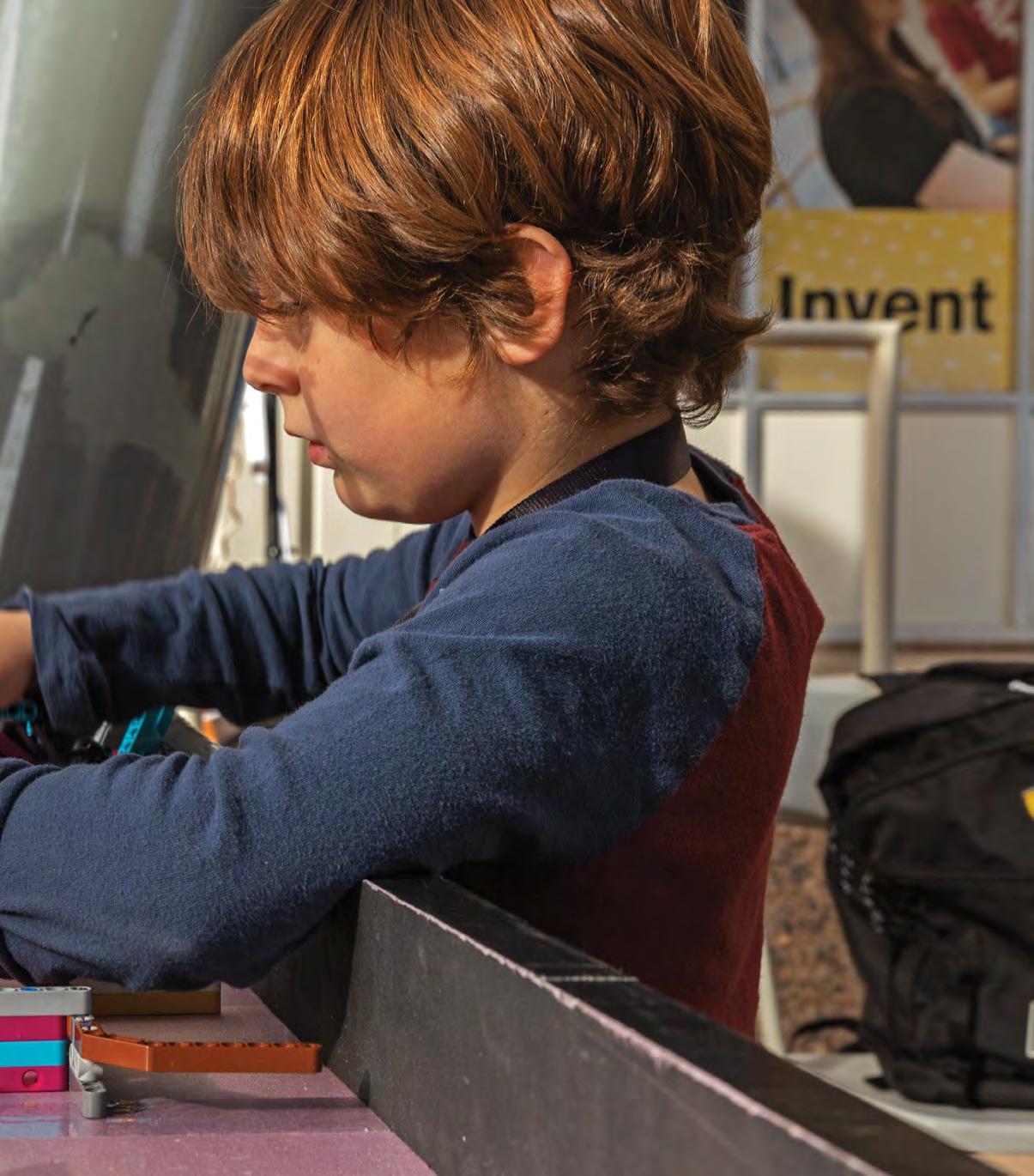
“Our son, Nate, wanted to stay the entire day. It’s so cool the number of hands-on experiences there are for kids. He thinks there should be an ASU Open Door every weekend.”
—
C HRIS RIKER, WHO BRINGS HIS SON TO OPEN DOOR EVENTS
ASU THRIVE MAGAZINE 7
Creating regional climate solutions Page 8 Top 10 worldwide for U.S. patents Page 9 Research
Nate Riker, 6, playing with a Lego contraption at ASU Open Door in Tempe.
and news
AI takes lead role in medical device accelerator
MedTech Accelerator, a collaboration between Mayo Clinic and ASU, launched its fifth cohort in March, bringing health technology innovators to Arizona. Nearly a third of the new cohort uses artificial intelligence for products such as 3D digital pathology imaging, a conversational AI health coach for seniors, automated EEG analysis and more.
Chris Camacho, president and CEO of Greater Phoenix Economic Council, says, “We’re seeing the future of medical care develop before our eyes.”
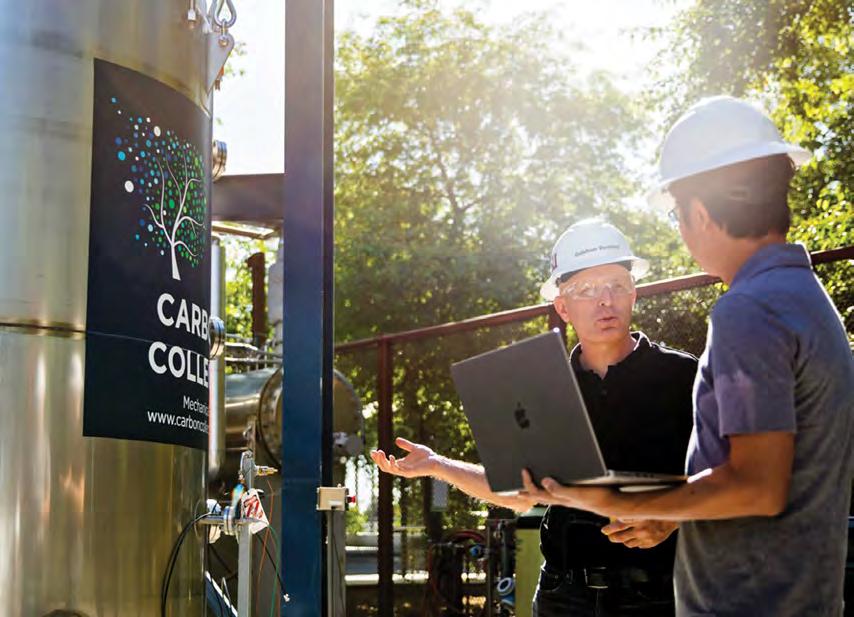
“The Southwest Sustainability Innovation Engine combines the extensive expertise of ASU and all our partners to ensure a sustainable future and prosperity for our region.”
— P ETER SCHLOSSER, DIRECTOR, JULIE ANN WRIGLEY GLOBAL FUTURES LABORATORY; VICE PRESIDENT AND VICE PROVOST OF GLOBAL FUTURES
ASU-led initiative will build regional climate economy and solutions
The National Science Foundation chose ASU to lead a multiinstitutional enterprise to confront climate challenges and spur economic development in the region.
The NSF Engines: Southwest Sustainability Innovation Engine unites more than 50 academic, community, nonprofit and industry partners throughout Arizona, Nevada and Utah to establish the desert Southwest as a leader in carbon capture, water security and renewable energy. It will help attract high-wage industries and create high-wage jobs that help mitigate the effects of climate change.
The NSF will fund SWSIE’s initial development and growth with $15 million over the next two years. The engine can be renewed for up to 10 years with up to $160 million in funding.
Learn more at swsie.asu.edu .
8 S UMMER 2024 NEWS
Top 10 in the world for US patents, along with MIT, Stanford and Harvard
ASU climbed to No. 9 in the annual ranking of the world’s universities for receiving U.S. utility patents. Among U.S. universities, ASU is ranked No. 7, ahead of the California Institute of Technology, Johns Hopkins University and the University of Pennsylvania.
This is the third time ASU made the top 10 worldwide in the ranking by the National Academy of Inventors.
ASU secured 170 U.S. utility patents in 2023 — an increase from 160 in 2022. One 2023 patent is for a treatment for colon cancer. Another is for an alternative to cement — and there are many more. Patents are key to taking innovations from the lab or fabrication and making viable commercial products.
Learn more at skysonginnovations.com .
“This is a testament to our faculty and staff whose perseverance and ingenuity place ASU at the forefront of supporting realworld solutions that benefit society.”
— S ALLY C. MORTON, EXECUTIVE VICE PRESIDENT, ASU KNOWLEDGE ENTERPRISE

LA high schoolers explore film creation
Los Angeles-area high school students created short-film scenes, working with faculty members of ASU’s Sidney Poitier New American Film School and California College of ASU to gain exposure to lighting, sound, acting and editing.
The hands-on learning experience was possible thanks to a partnership with the Firework Foundation, a nonprofit established by Katy Perry and her sister, Angela Lerche.
It took place in the historic California Center Broadway building in downtown LA.
Learn more at california.asu.edu
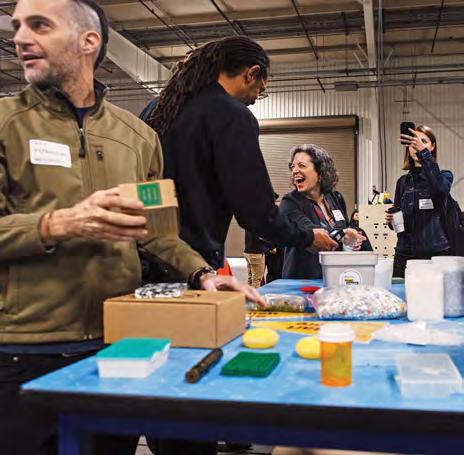
Attendees of the Plastics Microfactory Launch event inspect samples from different stages of the plastic recycling process.
First-of-its-kind plastics recycling microfactory to transform waste, create jobs
The new Circular Plastics Microfactory uses plastic waste to make new products. It’s a partnership between ASU, the city of Phoenix, Goodwill and Hustle PHX, a Black-owned, faithbased workforce development organization.
Located at the Goodwill Retail Operations Center in Phoenix, the facility takes sorted plastic waste from Goodwill and processes it into pellets they then use to create new items such as skateboards, flat-pack furniture and more. The microfactory, the first of its kind, is able to complete the entire process in one location.
Keep up with the headlines at ASU
by subscribing to the ASU News e-newsletter at news.asu.edu/ subscribe
The facility will employ about 10 people and is expected to save up to 550 tons of plastic from the landfill per year — over three times the weight of the Statue of Liberty.
After successfully scaling the Phoenix operation, researchers hope to be able to share the solution widely.
Learn more at circularlivinglab.org/projects/ plastics-microfactory.
DEANNA DENT; QUINTON KENDALL/ASU
ASU THRIVE MAGAZINE 9
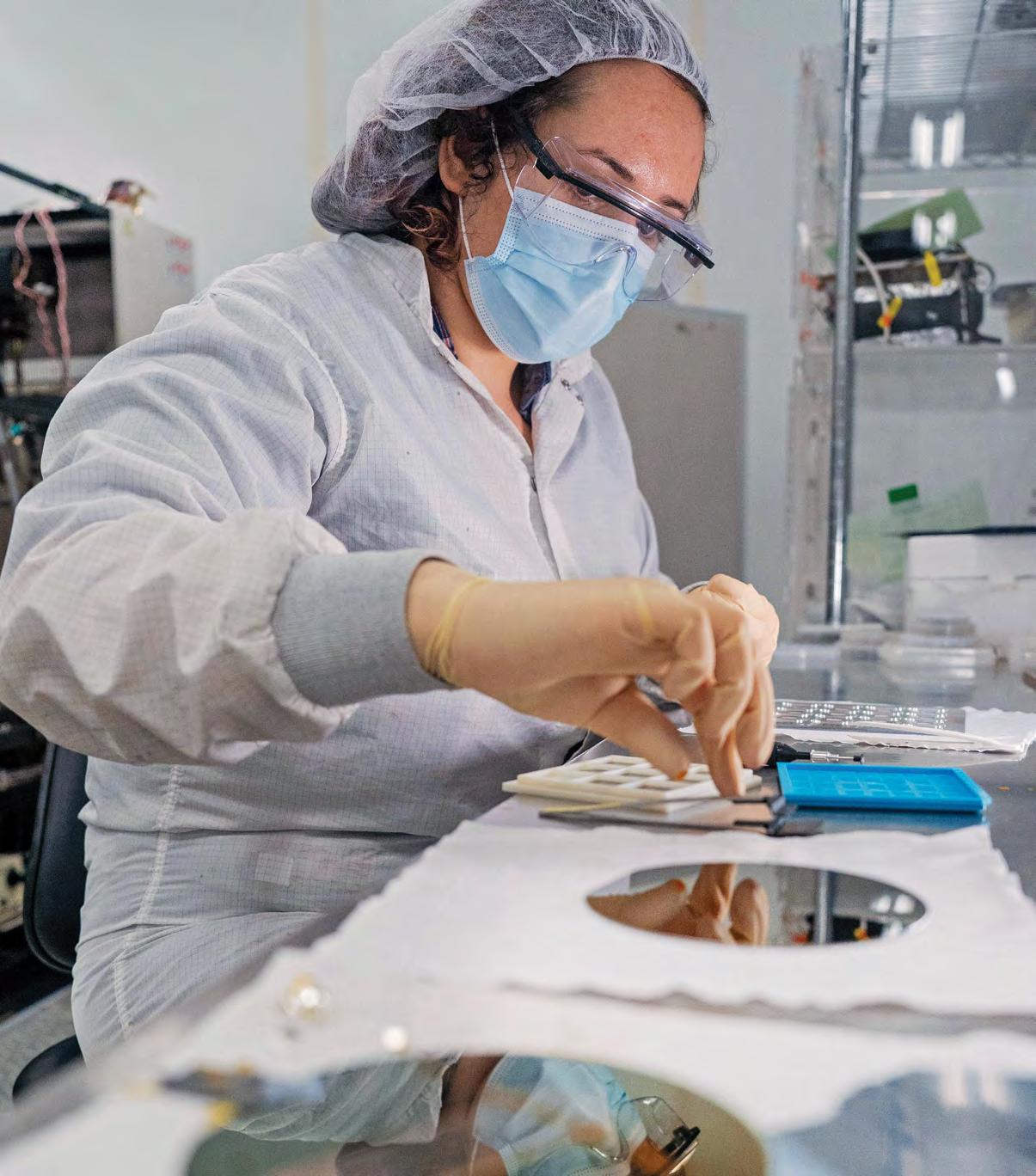
“This collaboration with ASU is a huge step.”
— R AMIN TOLOUI, ASSISTANT SECRETARY OF STATE FOR ECONOMIC AND BUSINESS AFFAIRS
SKILL BUILDING
Building the US microelectronics supply chain
The U.S. Department of State awarded a $13.8 million cooperative agreement to ASU to bolster assembly, testing and packaging capabilities in countries providing materials to U.S. semiconductor manufacturers.
The initiative helps International Technology Security and Innovation Fund partners create a pipeline of talent that will allow them to support the U.S. semiconductor industry.
The State Department and faculty members of the Ira A. Fulton Schools of Engineering and the W. P. Carey School of Business will lead the effort. The schools will provide the workforce skills international partners need to keep up with advancing technology and contribute to economic growth and prosperity.
Learn more at microelectronics.asu.edu
SAMANTHA CHOW/ASU 10 S UMMER 2024 NEWS
Maria Garcia works with lasers in a research area at the MacroTechnology Works in ASU Research Park in Tempe.
“Our approach from the start has been to ensure our knowledge core – ASU’s faculty, researchers and staff – is at the forefront of discovery.”
— LEV GONICK, ASU CHIEF INFORMATION OFFICER

From idea to impact: the AI Innovation Challenge
As part of the AI Innovation Challenge, innovators at ASU are advancing 105 projects that explore the use of ChatGPT Enterprise across academic, research and work environments. The challenge is supported by ASU’s collaboration with OpenAI.
From writing companions to simulating real-world scenarios, projects explore using the chatbot to enhance and scale learning opportunities. Examples include projects that employ the chatbot as a conversational tool –from learning a second language to simulating a patient experience for students in behavioral sciences.
Faculty have created projects for course development, such as generating dynamic study guides, interactive glossaries and graphics that enhance traditionally static learning materials.
In March, ASU expanded eligibility to let student researchers submit to access ChatGPT Enterprise in summer 2024. Additionally, faculty can submit proposals to use the AI tool with students in the courses they teach.
Learn more at ai.asu.edu .
Being funny has benefits in the dating world
When it comes to qualities that people find attractive in a potential romantic partner, a sense of humor is often high on the list.
Humor is a stress reliever. It creates a bonding experience. And, well, laughter just feels good. It also may be part of romantic attraction, according to ASU researchers Erika Langley, a PhD candidate in social psychology, and Michelle Shiota, an associate professor of social psychology.
Their research reveals that people in pursuit of a romantic partner attribute other positive qualities, like intelligence and creativity, to someone who can put a smile on their face.
Learn more at psychology.asu.edu .
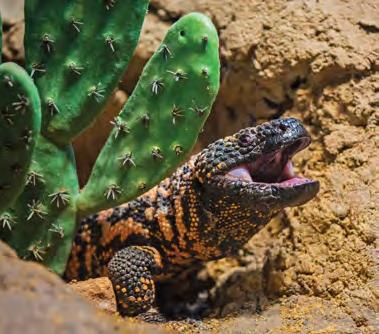
Researchers sequence Gila monster genome
Arizonans take pride in their Gila monster, so much so that in 2016, ASU evolutionary biologist Melissa Wilson launched a community-engaged campaign to support sequencing the creature’s genome. Now, Wilson’s team has accomplished that goal. They assembled the complete genome of the Gila monster, unlocking some of its secrets.
Some reptiles have an XX/XY system. Others, like the Gila monster, are different. Males typically have two Z chromosomes, while females typically have one Z and one W. The genome diversity can give researchers insights, especially in understudied reptiles, filling a knowledge gap about how evolution works.
The team continues to study Gila monsters. These creatures, for instance, store water that allows them to survive for up to 90 days without drinking.
Learn more at sols.asu.edu
“It feels incredible to be able to deliver on our promise to the community.”
— M ELISSA WILSON, ASU EVOLUTIONARY BIOLOGIST
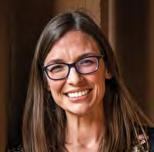
LOPEZ ASU THRIVE MAGAZINE 1 1
MIKE SANCHEZ/ASU; ENRIQUE
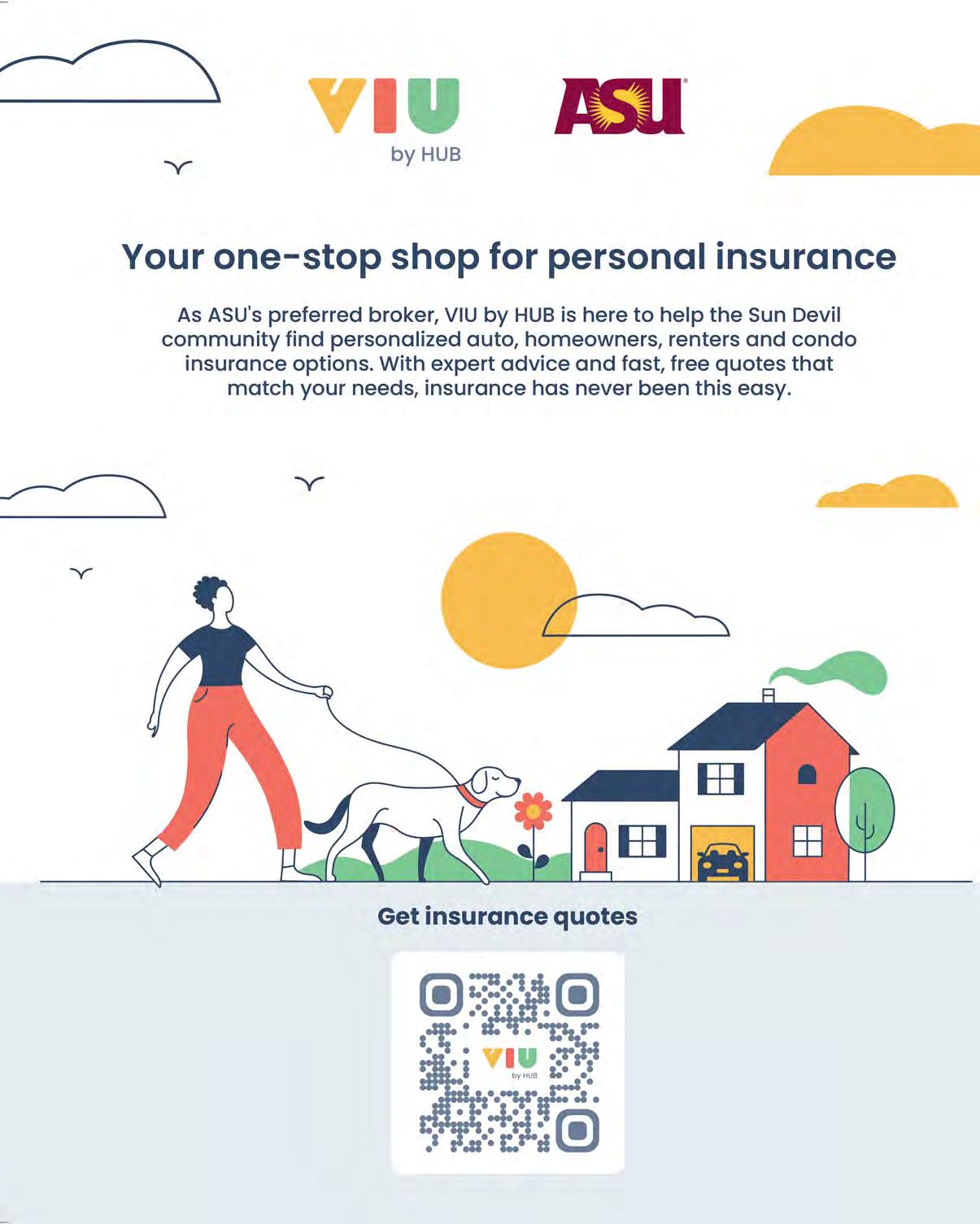
Career
Career tips
ASU alumni are succeeding in their careers around the world. Here, an alumnus shares tips.
Work in your field during college. Students develop their career foundations through one-on-one career coaching and resumebuilding support. They have a unique edge as they enter the market having had access to invaluable opportunities like contributing to media at the Super Bowl, the NCAA basketball tournament and other high profile, hands-on experiences. ASU journalism students earn positions at major media organizations such as The Arizona Republic and the LA Times, television stations, advertising firms and the city of Phoenix.
Andrew Onodera, ’22 BA in broadcast journalism and ’23 MMC, started as the multimedia director at The State Press. His experience helped him secure an internship at 12News in Phoenix, he says.
Complete an internship. ASU helps students find internships. Onodera made an impression during his that resulted in his full-time job.
Stay connected with ASU. “I find that my professors give great advice even after college,” Onodera says.
The career support ASU provides is a key part of why ASU ranks No. 2 in the U.S. for employability among public universities, ahead of UCLA, University of Michigan and Purdue.
Learn more at cronkite.asu.edu/students/ career-services/internships/list . Connect at linkedin.com/company/asualumni .

5 ways to improve your focus Page 14
SABIRA MADADY/ASU ASU THRIVE MAGAZINE 1 3
Andrew Onodera took an internship at KPNX 12News and was then hired full time.
Training to help you in your career Page 17 JOB SEARCH
Take breaks
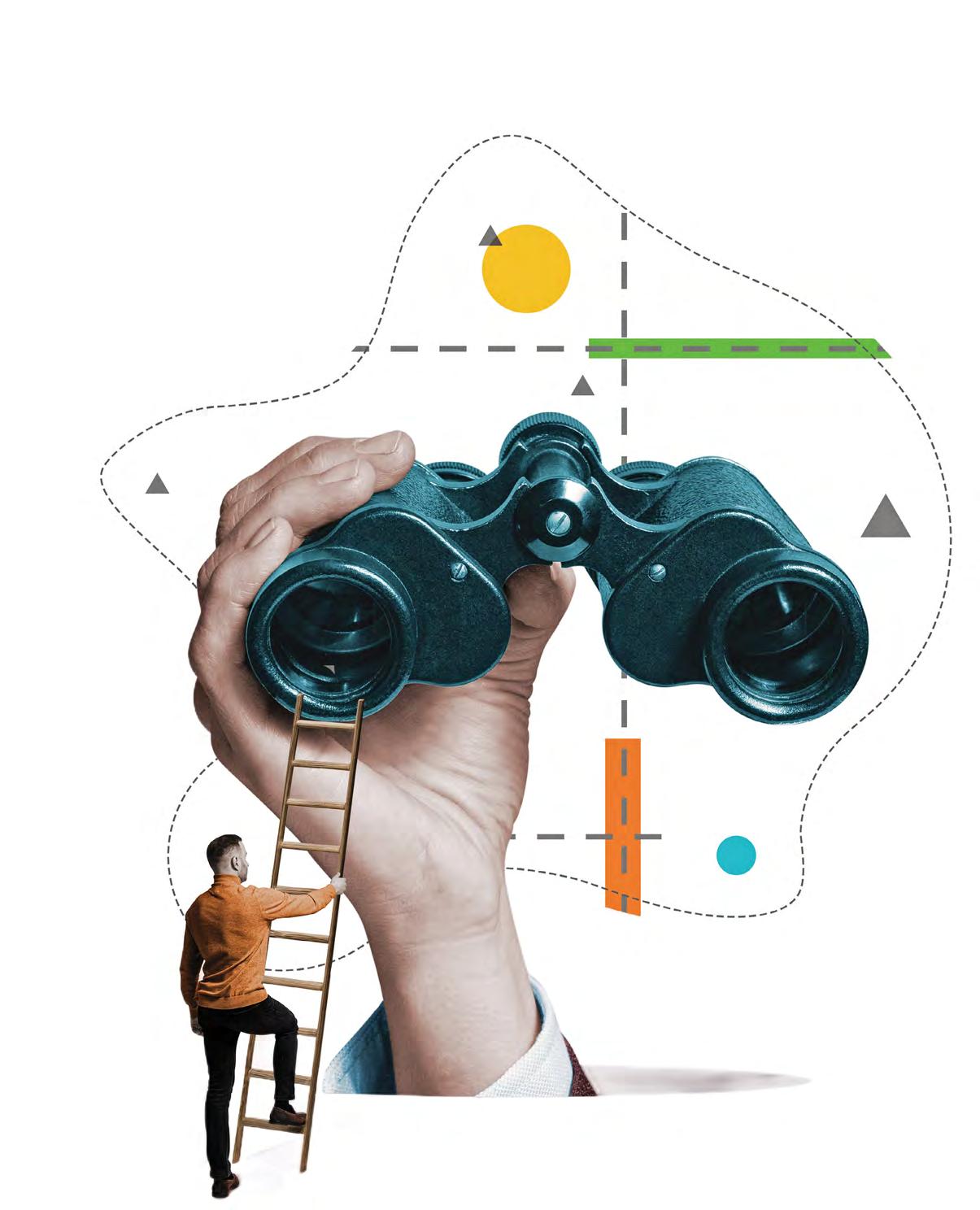
Batch tasks
Create a schedule
Try meditation or breathwork
Do 10-minute focus drills
CAREER 14 S UMMER 2024
improve
5 EASY WAYS TO your focus
Research shows that sharpening your concentration boosts productivity and shrinks stress
Story by STEPHANIE VOZZA
Do goldfish really have a longer attention span than the average person? No, thankfully, data busted that oncepopular myth.
Yet, people can find it challenging to concentrate on a single activity, especially in today’s work world with its many devices, tasks and interruptions.
“As demands have increased, our attention is getting pulled in a lot of directions,” says ASU Psychology Professor Gene Brewer.
We’re living in an age of information overload, adds Ned Wellman, ASU associate professor of management. “The amount of information we receive every day is more than ever before.”
To increase your focus, use these science-backed tips.
1. Create a schedule
Instead of diving into whatever seems important, take a few minutes to plan your day, suggests Wellman. In his research with NASA astronauts, he discovered
that how you run your day directly affects focus.
“Start with the tasks that are meaningful and consequential to you,” he says. “In addition to getting those things done, it creates what’s called a ‘cascade of engagement.’ You might be doing less interesting things throughout the day, but you’ll be amped up from completing those initial important tasks.”
2. Take breaks
While it sounds counterintuitive, building short breaks into your day can work wonders.
“We know from psychological research that when you’re trying to focus consistently, your ability deteriorates over time,” says Brewer. “If you give somebody a break, their focus is better when they return to the task.”

Brewer loves to use the example of former Arizona Cardinals coach Kliff Kingsbury, who gave players 5-minute cell phone breaks every 20 to 30 minutes during meetings that lasted an hour and a half.
“Everybody in the NFL thought Kliff was crazy, but breaks help people reset,” Brewer says.
3. Batch tasks
Another way to improve your focus is to concentrate on one task at a time instead of multitasking.
“Few people can do a bunch of random tasks without degrading their performance,” Brewer says. “Try to do one task at a time.”

Stephanie Vozza covers productivity, careers and leadership for Fast Company magazine.
ASU THRIVE MAGAZINE 1 5
For example, block time to answer email, work on a project or do research, only focusing on that one thing. Resist the temptation to check email outside of designated times.
Wellman says that when you switch from one challenge to another, part of your mind will remain engaged with the first task.
“It’s called ‘attention residue,’” he says. “It can keep you from focusing on the next task.”
Along those lines, turn off alerts on your phone, then check your phone only at designated times.
4. Try meditation or breathwork

Regular mindfulness exercises help your brain focus better, even if you allot just five or 10 minutes a day, says Wellman, who suggests setting aside some time first thing in the morning or whenever you need a small break during the day.
An easy way to meditate is to focus on your natural breath, dismissing thoughts as they enter your mind. You can also try breathwork, which activates your parasympathetic — rest and digest –nervous system, relieving stress. One way is to inhale deeply through your nose and exhale through your mouth. Start with three rounds of breaths and work up to five minutes.
5. Do 10-minute focus drills
Another way to build focus is to practice concentration drills, Wellman says. Doing this regularly may help improve your ability to focus over time. In the immediate term, it’s another way to give your brain a break from work tasks.
above tips. Creating a schedule, helping your brain focus with breathwork and breaks, and batching tasks all help you control the state of your environment.
Brewer also researches the extent to which you can change the way your brain works; in other
“The amount of information we receive every day is more than ever before.”
— NED WELLMAN, ASU ASSOCIATE PROFESSOR OF MANAGEMENT
For example, use your five senses to focus only on the food during a meal. Notice the flavors, textures and smells. Focus by counting how many times you chew, working your way up to at least 35 times per bite.
Another drill can be to practice active listening. Intently listen to what someone is saying without daydreaming or planning what you’ll say next. This takes a surprising amount of concentration.
Your ability to change
Focus involves state and trait factors, Brewer says.
“A trait is who you are,” he says. “You might be better at focusing in a distracting environment than someone else. But there may be days when your focus worsens because you don’t get enough sleep. That would be a state.”
Controlling the state of your environment to make it conducive to concentration can use all of the
words, how much influence you have over traits. Personality traits evolve over time, and they can be helped with regular practices, such as meditation. But changing a trait in the moment isn’t always possible.
The hope is that by gaining more understanding of the neural circuitry that supports mental focus, we can create more science-based interventions, such as pharmacological solutions, that allow people to focus better, Brewer says.
“Until then, we just have to use the state factors we can control,” he says. ��
Find more tools and tips
Browse career resources, from networking opportunities to interview coaching, at career.asu.edu .
16 S UMMER 2024
Lifelong learning
Training to help you earn promotions or shift your career
Navigate the digital world
Discover how media literacy principles can help you navigate the digital media environment. In “Mediactive: How to Participate in Your Digital World,” you will learn how to spot misinformation, assess credibility of sources and claims, use media to effectively participate in your community and more. asuforyou.asu.edu
Free Online
Career courses on demand
Whether you need guidance on your LinkedIn profile or want tips on how to use time more efficiently, Career Services has you covered with dozens of online courses you can access at any time. career.eoss.asu.edu

Free Networking Job search Online
Discover in-demand careers
Weighing your career options? Use Job Market Insights to explore your career of interest, growth projections and salary information. Use the tool to see the top companies hiring for those roles in your area. career.eoss.asu.edu
Free Networking Job search Online
Get started with AI
Designed for beginners, “AI Foundations: Scripting ChatGPT with Python” is presented in a digestible manner that avoids complex mathematics, focusing instead on practical, hands-on applications. Whether you’re an aspiring data scientist or AI engineer, a software developer or simply a tech enthusiast, this course serves as an exciting starting point. careercatalyst.asu.edu
Online Self-paced
Conquer burnout
Unlock the secrets to balance at work and in life. “Managing Stress and Time” offers practical tools and strategies that empower you to enhance your productivity and wellbeing. This course is your pathway to a more organized and stressfree life
careercatalyst.asu.edu
Online Self-paced
Think positive
Turn challenges into opportunities with “Positive Thinking and Thriving,” equipping you with the tools to cultivate a positive mindset amid life’s stressors. Discover the art of seeing the glass half full, finding deeper meaning in your experiences and empowering personal growth through optimism. careercatalyst.asu.edu
Online Self-paced
ASU THRIVE MAGAZINE 1 7 JILL RICHARDS
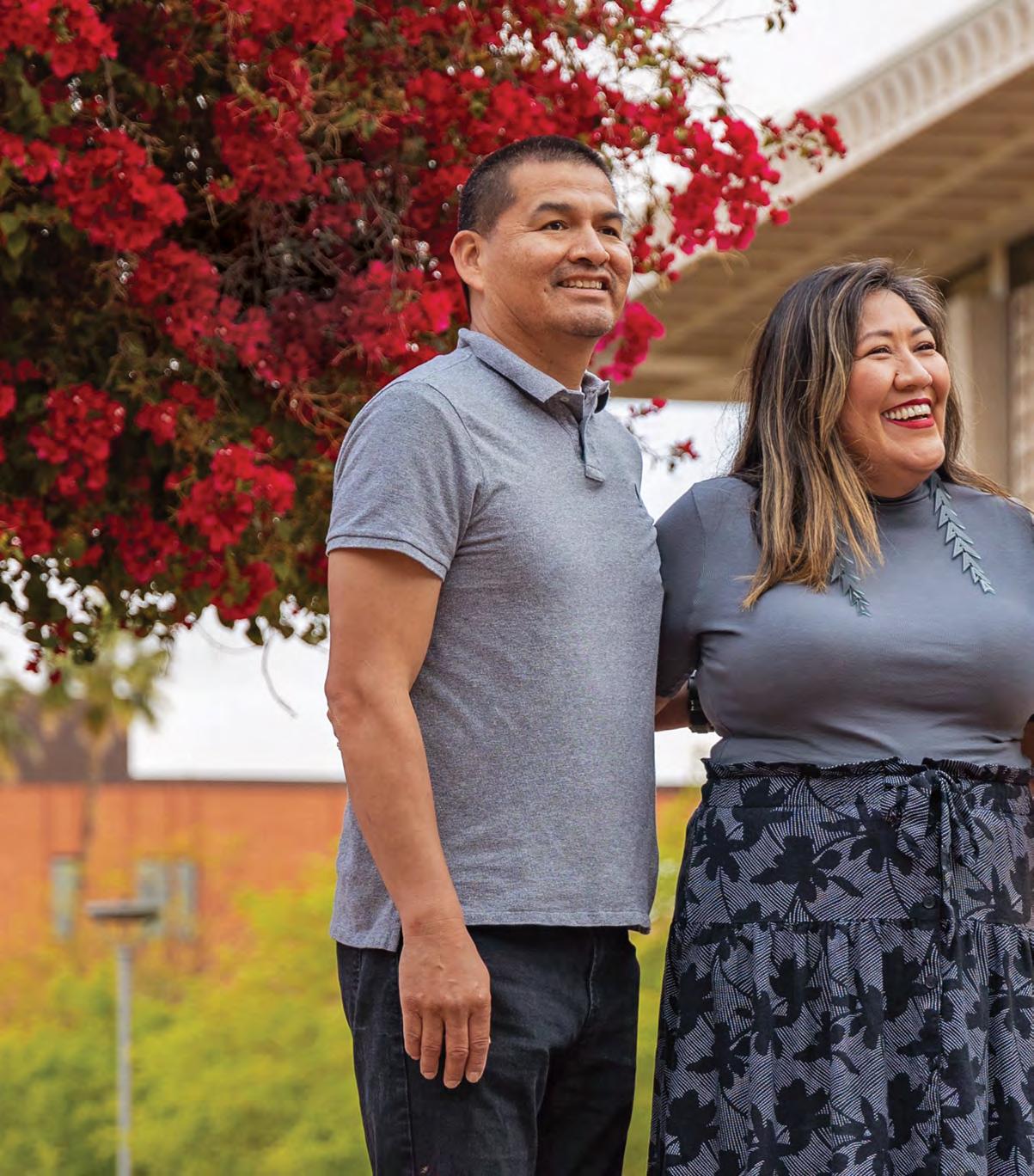
Coral Tachine is Diné from Ganado, Arizona, and is part of the Náneesht’ézhí Táchii’nii — Zuni Red Running into Water clan — and Tódich’ii’nii — Bitter Water clan.
MAKING A DIFFERENCE Celebrating grads
Coral Tachine, ’24 BA in American Indian studies, graduates this spring along with an estimated 20,300 other ASU students.
Tachine chose to attend ASU instead of another university because of the American Indian Studies program.
“I like the way that the AIS major looked, all the different courses that are part of it and the people involved,” she says. “I felt taken care of and nourished.”
She says the program taught her ways to bring past perspectives into today’s world — of how to think about Earth, land and human and non-human relatives.
“Hearing other students’ perspectives and our faculty members’ perspectives on things within my community or within their communities was really eye-opening.
“The program showed me how to merge these two different viewpoints of Native American and Western. I never thought that was possible before,” she says.
Tachine also earned a minor in film and media production. Her big dream is to someday start a production company that also teaches and supports Indigenous filmmakers.
“I want to help include more Indigenous voices in film and TV,” Tachine says. Learn more at americanindian.asu.edu
18 S UMMER 2024
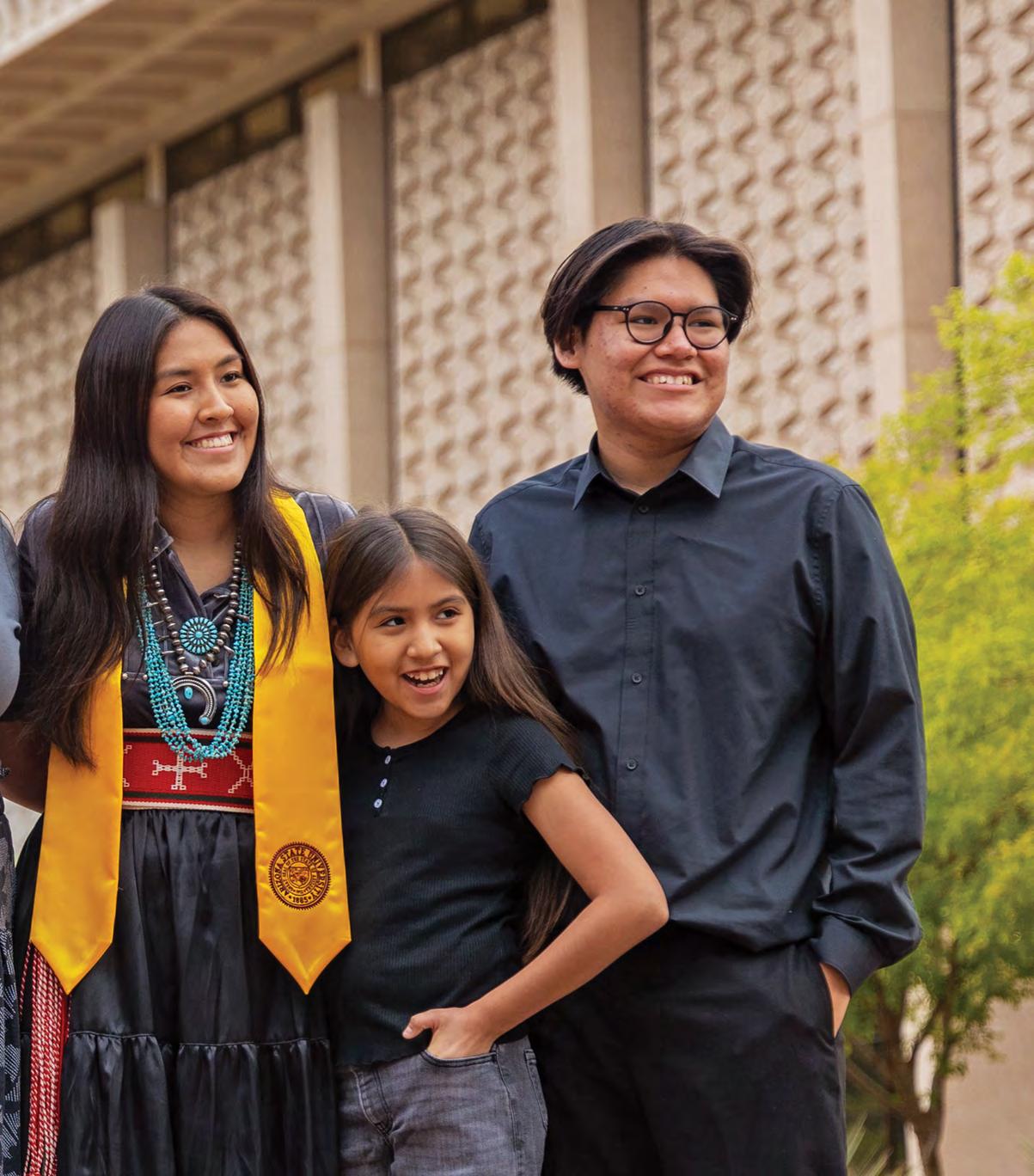
SABIRA MADADY/ASU ASU THRIVE MAGAZINE 1 9 2020-24 time capsule Page 20 Golden grads return Page 30 Commence
The Tachine family of Brian, Amanda, graduate Coral, Noelle and BJ. Coral says her family’s reassurance, support and love helped her through college.
2020–24 time capsule
It has been a wild four years, graduates. From cherished campus memories to pop culture trends, here’s a look back on your ASU journey.
STORY BY DAMIAN GOACHER, A JUNIOR MAJORING IN JOURNALISM AND MASS COMMUNICATION; GEORGE HEADLEY, A FIRST-YEAR STUDENT MAJORING IN JOURNALISM AND MASS COMMUNICATION; AND MADISON VEGA, A GRADUATING SENIOR MAJORING IN JOURNALISM AND MASS COMMUNICATION, WITH INPUT FROM COMMUNICATIONS AND DIGITAL MARKETING STUDENTS IN THE CRONKITE AGENCY.
20
20
2020: A grad odyssey
The university innovates. ASU’s spring commencement goes virtual and amasses over 30,000 views.

Playing on our phones
“Blinding Lights” by The Weeknd “Circles” by Post Malone
“The Box” by Roddy Ricch
“Don’t Start Now” by Dua Lipa “Rockstar” by DaBaby featuring Roddy Ricch
Research rally
ASU develops a saliva-based COVID-19 PCR test and, in collaboraton with the state, rolls it out to the public.
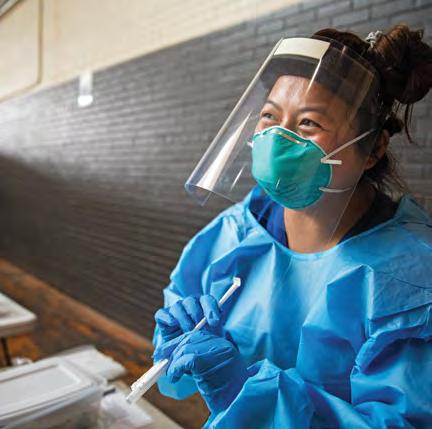
Fast‑ graduation nation
High schools turn to graduation drive-thrus to abide by pandemic policies. For those of you who are graduating from ASU this May, this may be your first in-person convocation. A welldeserved congratulations to you, grads!

Netflix’s ‘Gambit’ pays off
The streaming service releases “Tiger King” and “The Queen’s Gambit.” The latter starts a chess craze.
Hot gaming
Animal Crossing: New Horizons launches on Nintendo Switch, letting players live out their vacation dreams virtually during the pandemic.


A return to in‑person classes
After virtual lectures and at-home coursework, ASU students celebrate being back in in-person classrooms in the fall.
20 S UMMER 2024 ASU PHOTO; ALAMY STOCK PHOTO; WILLIAM WEST/AFP VIA GETTY IMAGES COMMENCE
The world resumes
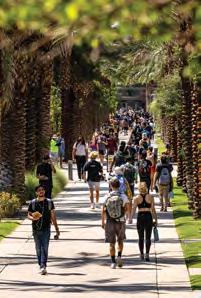
In 2020, the world shut down — you could roam the streets and not hear a peep. Not a mouse nor a sheep, as if Earth were in a monthslong sleep. Now, with forks in the air, to celebrate a new year, we head outside to resume our full lives, socialize with IRL friends and get back to what we like.
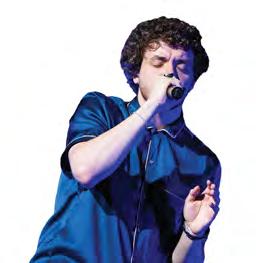
What’s Poppin’?
Oh, Jack Harlow is headlining?
Rapper Jack Harlow headlines at Inferno Fest, kicking off the 2021 school year.
Sun Devils learn in the City of Angels
TikTok revives ‘Good Soup’
From 2017’s “Girls,” it gets immortalized as a meme on the social network.
Fusion on First opens its doors
The 16-story, tech-driven project gives students the chance to grow with state-of-the-art creative workspaces while living and collaborating in downtown Phoenix.
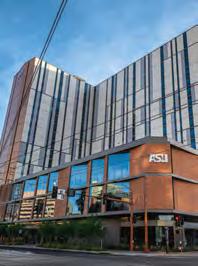
The university continues to expand in the Golden State with classes taking place in the ASU California Center in downtown LA.
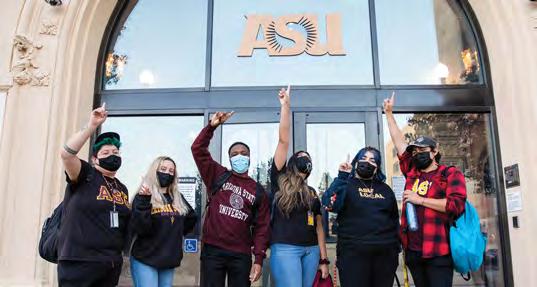
Thunderbird
lands at ASU’s Downtown Phoenix campus
ASU unveils the F. Francis and Dionne Najafi Global Headquarters during the 75th anniversary of the Thunderbird School of Global Management.

James Webb Telescope heads into the final frontier
NASA, with the help of ASU researchers, launches the largest, most powerful and complex space telescope ever built.
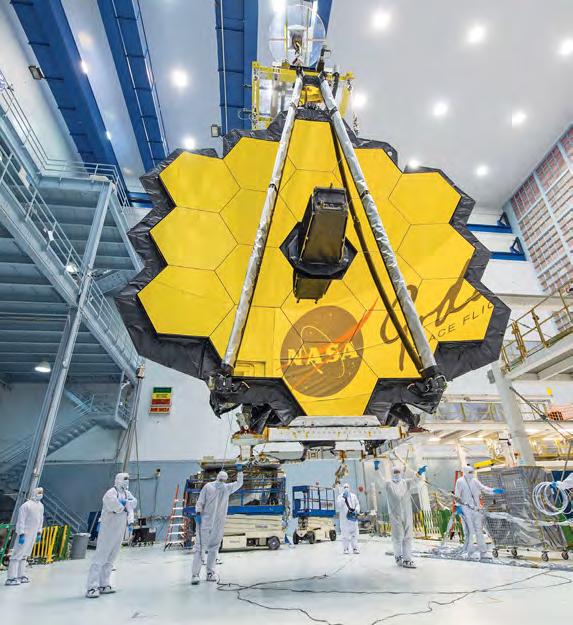
20 21
ASU THRIVE MAGAZINE 2 1 ASU PHOTO; NASA
20 22
Research activity increases 6 times over 20 years
The university ranks in the top 5% of universities with research expenditures.

King of Rock ’n’ Roll
The “Elvis” movie roars into theaters and gets people talking — and romping to the famous songs that created the genre.
The new frontier
The U.S. Space Force partners with the university to improve research and workforce opportunities in the stars.
A Sun Devil mind
Langston Tillman graduates with five bachelor’s degrees in STEM, social sciences and humanities. Yes, five degrees!
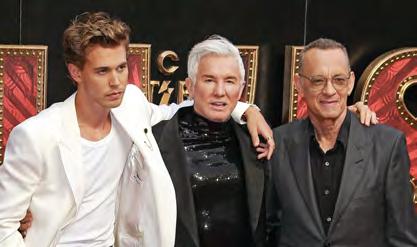

Miss America’s got a pitchfork
Emma Broyles, a Barrett, The Honors College student and ASU junior studying biomedical sciences, is the first Korean American to be crowned Miss America.
#1 1 in the US
for global impact
For the U.N. Sustainability Goals, ASU retains No. 1 in the U.S. for the third year in a row, ahead of MIT, New York University, Michigan State University and Penn State University.
Crow: innovator of innovation
The university celebrates Michael M. Crow’s first 20 years as president. He redefined what it means to be a publicresearch university and drove ASU to the No. 1 spot in innovation year after year.

22 S UMMER 2024 DEANNA DENT/ASU; FRED DUVAL/SHUTTERSTOCK
20 23
Taylor Swift phenomenon
The self-made billionaire continues to make headlines and set records and even helps the NFL win new fans. This time, for the Eras Tour, she kicks it off at State Farm Auditorium in Glendale.
Mom jeans
Gen Z popularizes high-waisted jeans, oversized blazers and hoodies, and chunky sneakers, in an updated look inspired by the late ’80s or maybe “Stranger Things.”
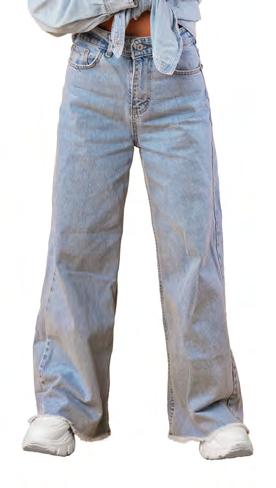

Starbucks’ pilot program
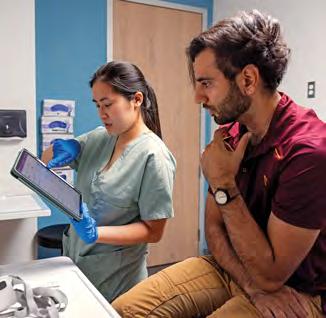
For Arizonans’ health
The university announces a medical school will open in downtown Phoenix along with a new school that focuses on public health technology.
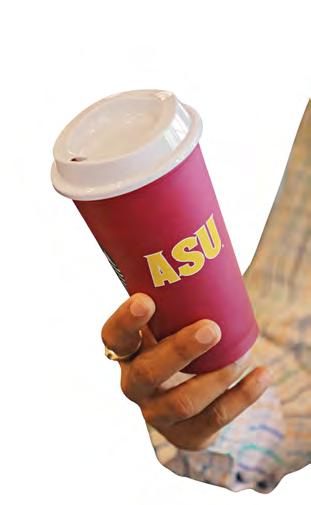
With the help of ASU, a location on the Tempe campus implements “Borrow a cup”; 50,000 beverages are served in reusable cups over the seven-month test.

Super Bowl LVII in the Valley
The Pat Tillman Foundation hosts the coin toss for football’s biggest game.
Alumni win golf’s top tournament
Jon Rahm, ’16 BA in communication, wins the Masters, placing him No. 1 in the world. Sun Devil and threetime champion Phil Mickelson, ’92 BA in psychology, ties for second place.

Fashion expansion in Los Angeles
ASU extends the Herberger Institute for Design and the Arts into Los Angeles with new fashion programs in ASU FIDM.
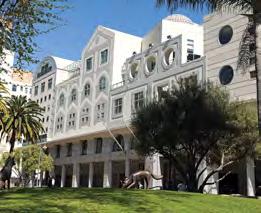
ASU THRIVE MAGAZINE 2 3 SIPA USA/ALAMY STOCK PHOTO; SAMANTHA CHOW/ASU; SEAN RYAN/IPS/SHUTTERSTOCK; CHRISTIAN PETERSEN/GETTY IMAGES
Chart topper
Beyoncé announces a country album at the Super Bowl and it hits the charts.
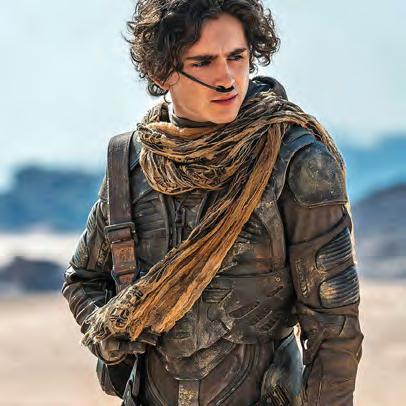

ASU collab with OpenAI
Wait? So AI is allowed at school? That’s right. ASU and OpenAI seek to enhance education and workforce skills.
#1 ranking on more than a dozen national and international lists
#1 innovation ahead of MIT and Stanford, according to U.S. News & World Report, 2016—24.
#1 sustainability ahead of Stanford and UC Berkeley in the Sustainability Tracking, Assessment & Rating System.
#1 for the largest pipeline of engineering and tech talent in the U.S., ahead of MIT, Stanford and UCLA, according to the American Society for Engineering Education.
‘Dune: Part Two’
The long-awaited sequel hits theaters, debuting as the highestrated sci-fi film on IMDb.
Students get a once-ina-lifetime experience

The university “hosts” the Final Four in Glendale, involving dozens of ASU community members across professions and majors. The last time ASU hosted was in 2017.
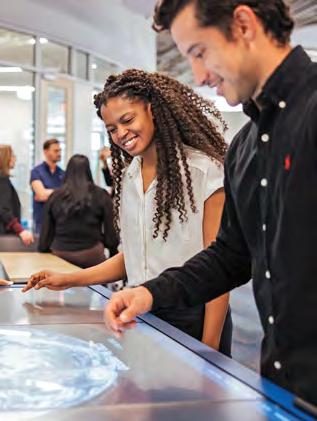 By the numbers #ASUgrad
By the numbers #ASUgrad
Top producer of graduates
ASU serves learners in all 50 states plus Washington, D.C., Guam, Puerto Rico and the U.S. Virgin Islands. With a total of 605,423 alumni in 2023, ASU annually graduates thousands of innovators who excel in engineering, business, education, the arts and other fields.
‘The Best Colleges for Future Leaders’
ASU, along with the University of Michigan, UC Berkeley and the University of Texas, topped this most recent 2023 list by Time.
#2 in the US for employability
ASU ranks top among public universities, ahead of UCLA, University of Michigan and Purdue in the Global Employability University Ranking and Survey in 2024.
Over 20,300 total grads
Number who applied for graduation for all degrees in the Spring Class of 2024.
Over 13,000 undergraduate students applied to earn their degrees.
Almost
7,300 graduate students applied to receive their degrees.
46% from Arizona
Almost half of the Class of Spring 2024 hails from Arizona.
SOURCE: UNIVERSITY OFFICE OF INSTITUTIONAL ANALYSIS AS OF MARCH 18.
20 24
Degrees
NAU 7,139 UArizona 11,059 2012 2014 2016 2018 2020 2019 2017 2015 2013 2021 2023 2022 ASU 35,853 5,000 10,000 15,000 20,000 25,000 30,000 35,000 40,000 All figures are based on Integrated Postsecondary Education Data System reporting
awarded
24 S UMMER 2024 FLIXPIX/ALAMY STOCK PHOTO; KEVIN MAZUR/GETTY IMAGES FOR THE RECORDING ACADEMY; ASU PHOTO

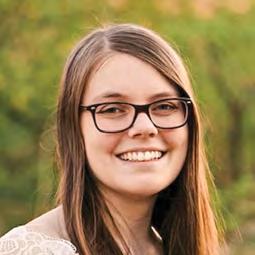
Katie Pascavis
• ’ 23 BS in mechanical engineering, ’23 BA in global health.
• O ne of only 40 winners of the Marshall Scholarship in 2023; won a Goldwater Scholarship and the Udall Scholarship.
• Pursing MPHil in engineering for sustainable development at the University of Cambridge, U.K.
“It’s basically a yearlong crash course on the complex problems surrounding sustainability, climate change and international development and how engineers can help.”
While at ASU, she filed two utility patents and served as president of ASU’s Engineers Without Borders club. She plans to work on global water issues as her next career step.
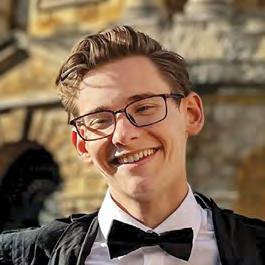
Nathaniel Ross
• ’ 22 BS in biological sciences, BS in political science, BS in applied quantum science, BA in history, ’23 MS in biology.
• Won a Rhodes Scholarship in 2022 and Udall Scholarship in 2021.
• Studying comparative social policy, investigating the intersection between disability and poverty at Oxford University.
“As a Rhodes Scholar, I hope to shed more light on the challenges faced by disabled Americans while also identifying potential solutions.”
One of 32 American Rhodes Scholars, Ross was one of only three winners to have graduated from a public university in 2022. He also received a Critical Language Scholarship from the State Department to study Russian. His experience will help him in his career leading disability policy in the U.S.
Arizona, United States
Top producer of Fulbright awardees
In the 2023-24 application cycle, ASU ranked 6th overall among doctoral-granting institutions for faculty awards with eight recipients, and 21st overall for student awards with 21 recipients. ASU is one of only seven doctoral-level institutions recognized as a Fulbright Dual Top Producer for its status as a top performer in both student and scholar awards, along with the University of Southern California and George Washington University. Over the last 10 years, 159 ASU applicants have received Fulbright U.S. Student awards, making ASU 15th overall, ahead of UC Berkeley, Duke and the University of North Carolina. Learn more at onsa.asu.edu/scholarships .
SEC TK
United Kingdom
26 S UMMER 2024 COMMENCE
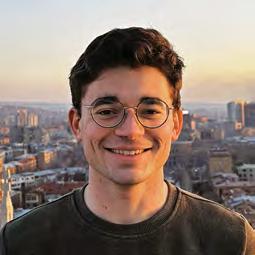
Collin Frank
• ’ 22 BA in global studies and BA in Russian.
• Won a Fulbright English Teaching Award and the 2023 Thomas R. Pickering Foreign Affairs Graduate Fellowship.
• Fulbright Teaching Assistant in Yerevan, Armenia.
“ I’m impressed by the students’ drive and tenacity. Some take long bus rides to the university, nearly all work and everyone masters at least two foreign languages.”
In 2025, Frank will enter the U.S. foreign service. ASU helped him develop the key 13 dimensions required for foreign service officers and earn the Pickering fellowship.
Catching up with elite scholars
Worldwide
impact
Every year, ASU students earn elite international scholarships. Here’s what four of the elite scholars abroad are learning to help create a better world.
— Story by Wendy Paris
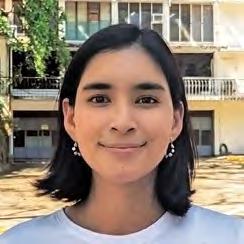
Isabela Huckabee
Armenia
• ’ 23 BS in Earth and space exploration (astrophysics).
• Won a Fulbright Study/ Research Award.
• Conducting research on astronomy in the Philippines.
“I hope it helps us understand why things are the way they are here. How is the development of space different than in the United States?”
During her fellowship, Huckabee connects with space-focused student groups and creates lab modules for students’ use to help Filipinos propel the space industry forward.
Philippines
ASU THRIVE MAGAZINE 2 7 COURTESY OF KATIE PASCAVIS, NATHANIEL ROSS, COLLIN FRANK, ISABELA HUCKABEE
EARLY START On a path to neurosurgery
Dallas Salas, ’24 BS in neuroscience, graduated at age 19 and hopes to become a neurosurgeon.
Salas began earning college credits at age 12 while attending ASU Prep Digital. In community college, he continued earning credits with ASU Earned Admission courses.
Salas overcame struggles, including childhood leukemia and his family being houseless after a home fire.
At ASU as an online student, he joined Neurodevils, a club for students passionate about neuroscience. He also dove into research at the Memory and Attention Control Laboratory and presented at The College of Liberal Arts and Sciences’ first-ever Online Undergraduate Research Scholars Symposium.
Learn more about ASU Earned Admission at ea.asu.edu .

Dallas Salas with his mother, Constance. He’s wearing cords from the National Society of Leadership and Success, the Rainbow Convocation and the Psi Chi Psychology Association, and a cord for graduating magna cum laude.
28 S UMMER 2024 COMMENCE

“Getting the chance to take a lead with my mentors on a research project was amazing. We worked together from the beginning of the project to the end and presented it at the symposium.”
— D ALLAS SALAS, ’24 BS IN NEUROSCIENCE, ASU ONLINE GRAD AND PHOENIX RESIDENT
ASU THRIVE MAGAZINE 2 9 JILL RICHARDS
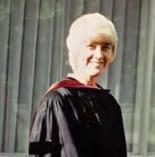
Degree: ’74 JD from the ASU College of Law
Major career milestone Justice on the Arizona Supreme Court from 1998 until 2009; Chief Justice, 2005-09
Favorite ASU memory
“I think my fondest memory might be studying for our first semester exams,” McGregor says. “We all felt so much that we were in it together.”
McGregor was in the fifth class of the ASU College of Law. Being part of the law school in its beginning stages meant she was helping create a path for future students. McGregor’s grandniece, Jacqueline Cochrane, graduates in May 2024 with her Juris Doctor, exactly 50 years after her grandaunt. Afterward, Cochrane will be moving to Dallas to pursue a career in personal injury law.
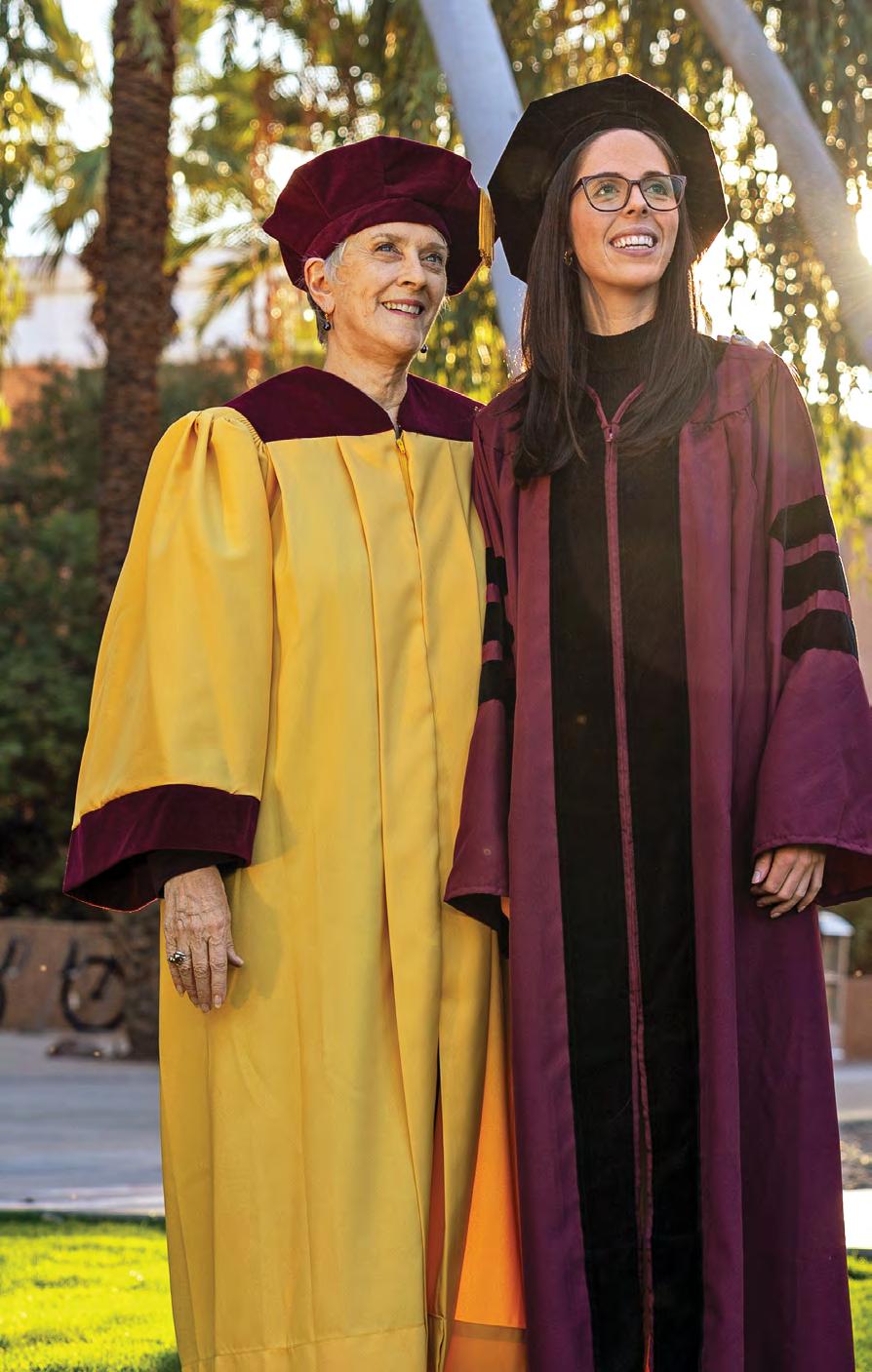
“It’s been wonderful seeing my grandniece going through classes and talking with her and listening to her. It’s really brought back a lot of memories for me.”
— RUTH MCGREGOR, ’74 JD, FORMER CHIEF JUSTICE OF THE ARIZONA SUPREME COURT
30 S UMMER 2024
SABIRA MADADY/ASU COMMENCE
Ruth McGregor


return Golden Grads
ASU THRIVE MAGAZINE 3 1
Alumni celebrate the 50th anniversary of their commencement
Ruth McGregor and Mark Kerrigan came back to campus with other Golden Grads for commencement events.

Degree: ’74 BS in political science
Major career milestones
Worked at the White House Office of Management and Budget, appointee to the Department of Energy
Favorite ASU memory
“When I had the opportunity to be president of the student body, that was really a tremendous year for me,” Kerrigan says. “We testified before the state legislature, traveled and raised money for the university. And it was just a fantastic experience.”
Kerrigan has fond memories of his time at ASU, calling it his happy place and says today, ASU stands better than ever.
Story by Damian Goacher, a junior majoring in journalism and mass communication
Learn more about the Golden Grads program and other opportunities at alumni.asu.edu.

“I really enjoyed my whole time here. This is one of my happy places. I love this campus. I love everything about the university. They’re doing phenomenally well.”
— MARK KERRIGAN, ’74 BS IN POLITICAL SCIENCE, WAS STUDENT BODY PRESIDENT AT ASU AND WORKED AT THE WHITE HOUSE OFFICE OF MANAGEMENT AND BUDGET AND THE U.S. DEPARTMENT OF ENERGY.
32 S UMMER 2024
SABIRA MADADY/ASU
Mark Kerrigan
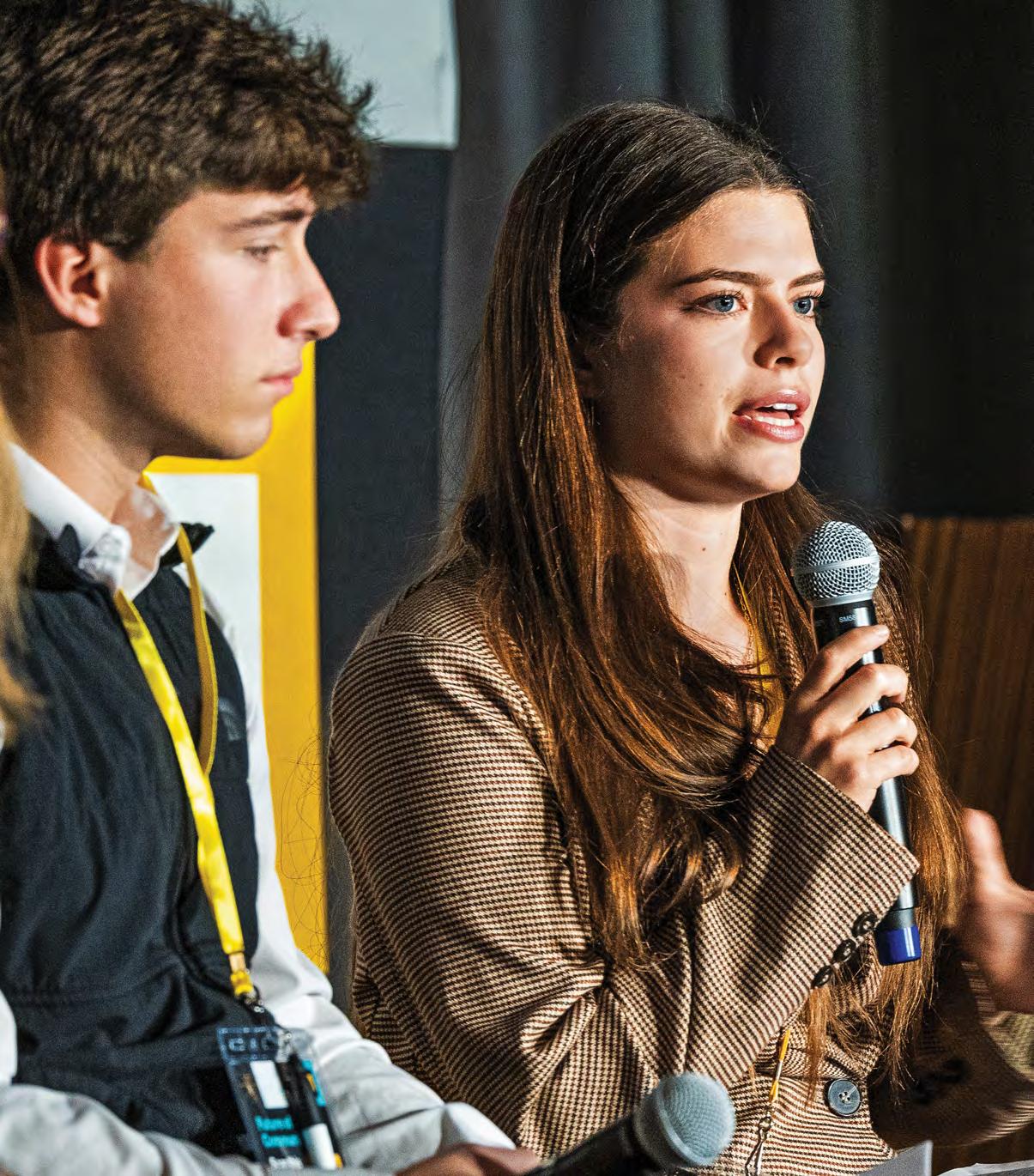
DRIVING CHANGE
Innovations in learning
More than 1,000 ASU faculty, staff and students attended the Future of Learning Community Fest. Sessions focused on the role of artificial intelligence in preparing students for the future, and other topics, including innovation and fostering personal connections.
Lev Gonick, ASU enterprise chief information officer, said that the university is working on creating several large language models for staff, faculty and students, including ASUGPT, to improve efficiency, predictability and accuracy.
Personal connection is “where true innovation and learning come from — when you’re seen as an individual,” says Sophia Herman, a third-year student majoring in English and civic and economic thought and leadership. Learn more at ai.asu.edu
Advance
CHARLIE LEIGHT/ASU ASU THRIVE MAGAZINE 3 3
AIpowered medicine
Page 34
The rise of a first-gen graduate at Intel
Page 44
Undergrads
Caleb Lieberman and Sophia Herman speak at the Student Keynote Panel.
The
human body is dripping in data, from the steady beat of the heart

August HaysEkeland’s research with the Neural Engineering Lab focuses on the part of the brain responsible for speech output.
34 S UMMER 2024 ADVANCE
to electrical impulses shooting through the brain,

to the myriad ways we walk and talk.
AI-powered medicine
ASU researchers are using artificial intelligence to improve health
Story by AMIT KATWALA
Photos by JEFF NEWTON
ASU THRIVE MAGAZINE 3 5
Tapping into that information to treat patients is one of the great challenges faced by doctors all over the world — but it’s being made easier thanks to advances in artificial intelligence.
ASU researchers are at the forefront of this new wave of medical research. Here are just some of the ways they are exploring how AI and machine learning can be used to speed up diagnosis, unlock new treatments and access new data sources that could shed light on the mysteries inside us all.
Assessing treatments for neurological conditions
Speech demands precise choreography – tongue, lips and jaw moving in harmony. But in neurological conditions like Alzheimer’s, Parkinson’s and ALS, those movements break down.
Sufferers may experience slurred and slowed speech, difficulties in recalling words, and instances of incoherent speech, says Visar Berisha, associate dean and professor in ASU’s Ira A. Fulton Schools of Engineering and professor in the College of Health Solutions. Berisha and Julie Liss are developing AI models that analyze both the content of someone’s words and the way they sound to “reverse engineer” what’s happening.
“The speech signal is very rich and has a lot of information about the state of a person and their health and emotions,” says Liss, an associate dean and professor in
the College of Health Solutions.
In 2015, Liss and Berisha co-founded a spinout company to bring the insights to patient care. While some startups are trying to use speech to diagnose conditions like Alzheimer’s, Liss and Berisha are taking a more conservative approach with potential for immediate impact.
Across many neurodegenerative conditions, there is a high failure rate in clinical trials. This is because the tools used to evaluate whether patients are improving from treatments are coarse and subjective. To solve this, Berisha and Liss use their AI model to evaluate whether patients are responding to treatment in clinical trials, with success already demonstrated in prospective trials in ALS.
These and other successes have led to breakthrough device designation status from the Food and Drug Administration, device registration with the FDA and global adoption by pharmaceutical companies and health care providers to track patient health.
“Speech analytics provide objective, interpretable, clinically meaningful measures that allow for clinical decision-making,” says Berisha. The hope is that AI will be able to pick up subtle changes

in speech that a clinician might have missed.
Standardizing brain scans
Inside the brain, Alzheimer’s is characterized by the growth of amyloid plaques, clumps of abnormal proteins that form in the gaps between neurons. New treatments such as lecanemab target these plaques. To track how these drugs are working, subjects in clinical trials are injected with a radioactive tracer that sticks to the amyloid so that it shows up on a PET scanner.
There are five different FDA-approved tracers, all with
36 S UMMER 2024

different properties, and different clinics use different tracers, making it hard for researchers to compare data. AI can help.
Teresa Wu, a professor in ASU’s School of Computing and Augmented Intelligence and health solutions ambassador in the College of Health Solutions, uses AI to harmonize PET scans taken with different types of tracers.
Wu’s model generates what a brain scan taken using one type of tracer would look like if it had been taken with a different one, enabling easier comparison and research.
“If you want to make use of imaging data to support medical
decisions, there is a hurdle to overcome,” she says. “You cannot just take the data from different sources and dump it in your deep-learning model. You have to make sure it’s clinically relevant and usable.”
Doing that opens a wealth of new opportunities for using AI to improve diagnosis.
Another project uses AI and deep learning to predict a person’s biological age from MRI brain scans.
“With healthy subjects you expect their biological age and their true age to be similar,” Wu says.
If it’s not, that could be an early sign of neurodegenerative disease.
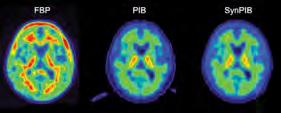
Teresa Wu and team use AI to combine PET scans that use different tracers. From left: FBP tracer PET scan, PIB tracer PET scan, AI-Generated PIB tracer PET.
Plugging into the brain
Locked-in syndrome, caused by damage to the brainstem, stops signals from the brain from reaching the rest of the body. The person
PhD student Maitry Trivedi works with Teresa Wu’s team using AI for Alzheimer’s research.
ASU THRIVE MAGAZINE 3 7
can see and hear, but they’re robbed of their ability to move, speak and communicate through anything but eye movements and blinking.
Bradley Greger, an associate professor in ASU’s School of Biological and Health Systems Engineering, is using artificial intelligence and machine learning to translate what’s happening in the brain in the hope of helping people with locked-in syndrome communicate more fluidly.
“It’s about tapping into those areas of the brain that process language and speech, recording the neural activity, and then using machine learning algorithms to figure out how that neural signal maps to the word they’re trying to speak,” he explains.
The research piggybacks on patients who are already having surgery to place electrodes in their brain to treat conditions such as epilepsy. Greger says this is the only way to get the detailed level of information needed — noninvasive brain scanning techniques like EEG and fMRI aren’t precise enough.
“Machine learning really helps with processing the huge amount of data that’s generated — terabytes of data,” Greger continues. “And then you have to map that onto the person’s behavior and what they’re saying.”
That information then can be used to train a model to predict what a person is trying to say.
Greger also notes that the brain is active while listening to speech — even in patients who are locked in.
“Ultimately, we’ll be able to understand not only what the patient is saying, we’ll also be able
“Machine learning really helps with processing the huge amount of data that’s generated — terabytes of data.”
— BRADLEY GREGER, ASSOCIATE PROFESSOR IN ASU’S SCHOOL OF BIOLOGICAL AND HEALTH SYSTEMS ENGINEERING
to confirm cognitive understanding when listening to speech,” he says.
Greger hopes to use this research for other applications: enabling paralyzed people to control a robotic limb, for instance, or blind people to see with the aid of a camera connected to the retina, optic nerve or visual processing areas of the brain.
“For somebody who’s blind or paralyzed, it can be really life-changing for millions of people,” he says.
Training therapists
How do you train a therapist? You start by hiring actors. Right now, practice patients played by budding TV and movie stars are one of the best ways to re-create scenarios a therapist might face in sessions.
But there are problems with that approach. First, how do you get the training to people in remote areas who don’t have a supply of actors? How do you make sure the actors provide the same experience?
Psychologist Thomas Parsons, the Grace Center Professor of Innovation in Clinical Education, Simulation Science and Immersive Technology, is using AI to create virtual standardized patients that he hopes will solve some of these problems.
Parsons, an Air Force veteran, is particularly interested in helping clinicians better treat ex-military patients with blast injuries, combat stress symptoms and insomnia.
He’s the lead investigator on a more than $5.2 million project supported by the Department of Defense Congressionally Directed Medical Research Programs* that trains an AI virtual patient using transcripts and video recordings of sessions between real patients and doctors. That will be combined with digitized recordings of actors to create realistic virtual patients who can say what a real patient would say.
Eventually, Parsons says, the system will be able to assess the clinicians’ performance and adapt.
“There are specific things that you’re supposed to ask in a structured clinical interview, and we can look at how the human is deviating from that,” he says. “And
*The work was supported by the Assistant Secretary of Defense for Health Affairs endorsed by the Department of Defense, in the amount of $5,072,397.00, through the Congressionally Directed Medical Research Programs Peer Reviewed Medical Research Program under Award No. HT9425-23-1-1080. Interpretations, conclusions and recommendations are those of the author and are not necessarily endorsed by the Assistant Secretary of Defense for Health Affairs or the Department of Defense.
38 S UMMER 2024
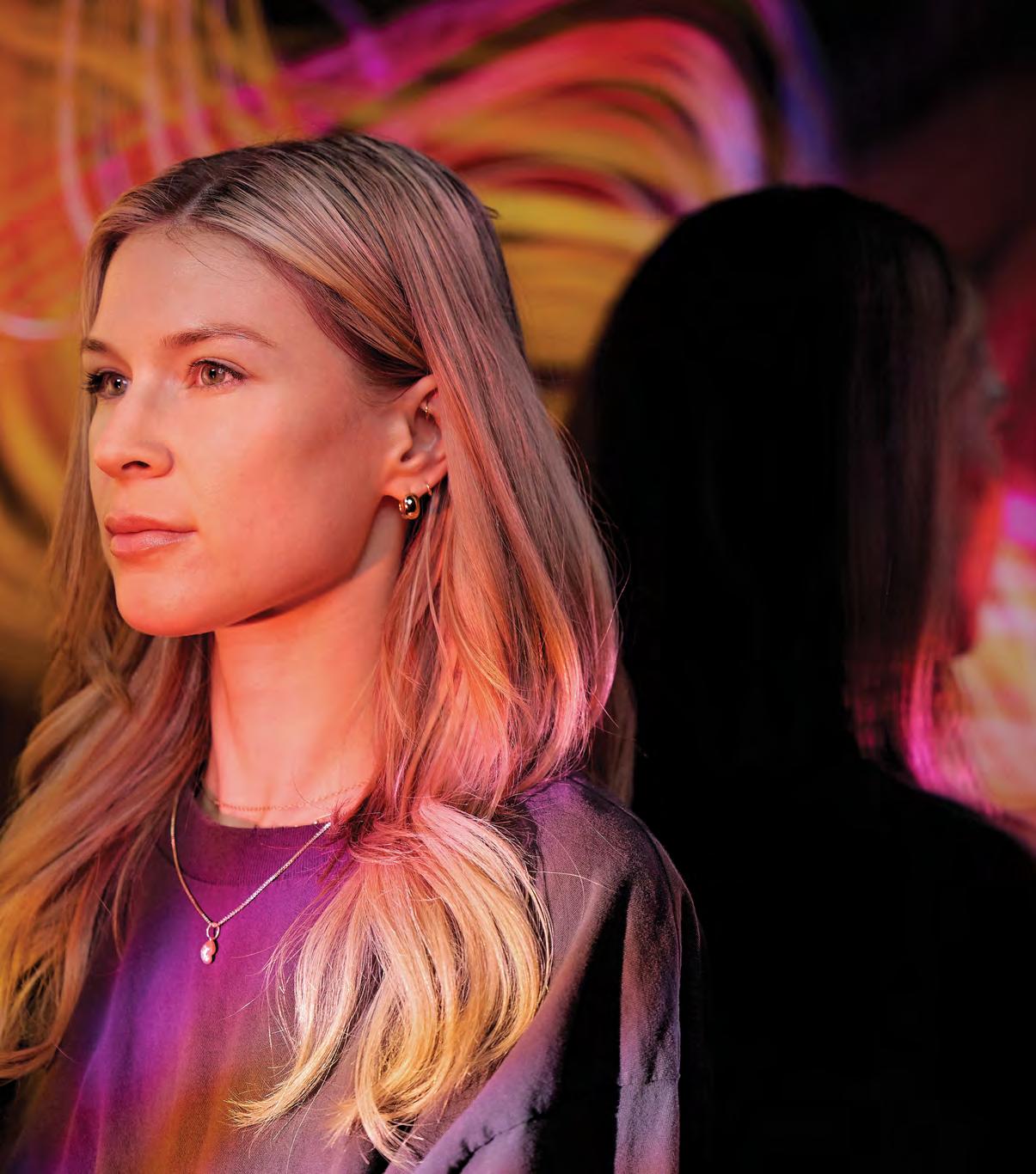
ASU THRIVE MAGAZINE 3 9
August Hays-Ekeland and Associate Professor Bradley Greger’s work aims to help people with locked-in syndrome communicate.
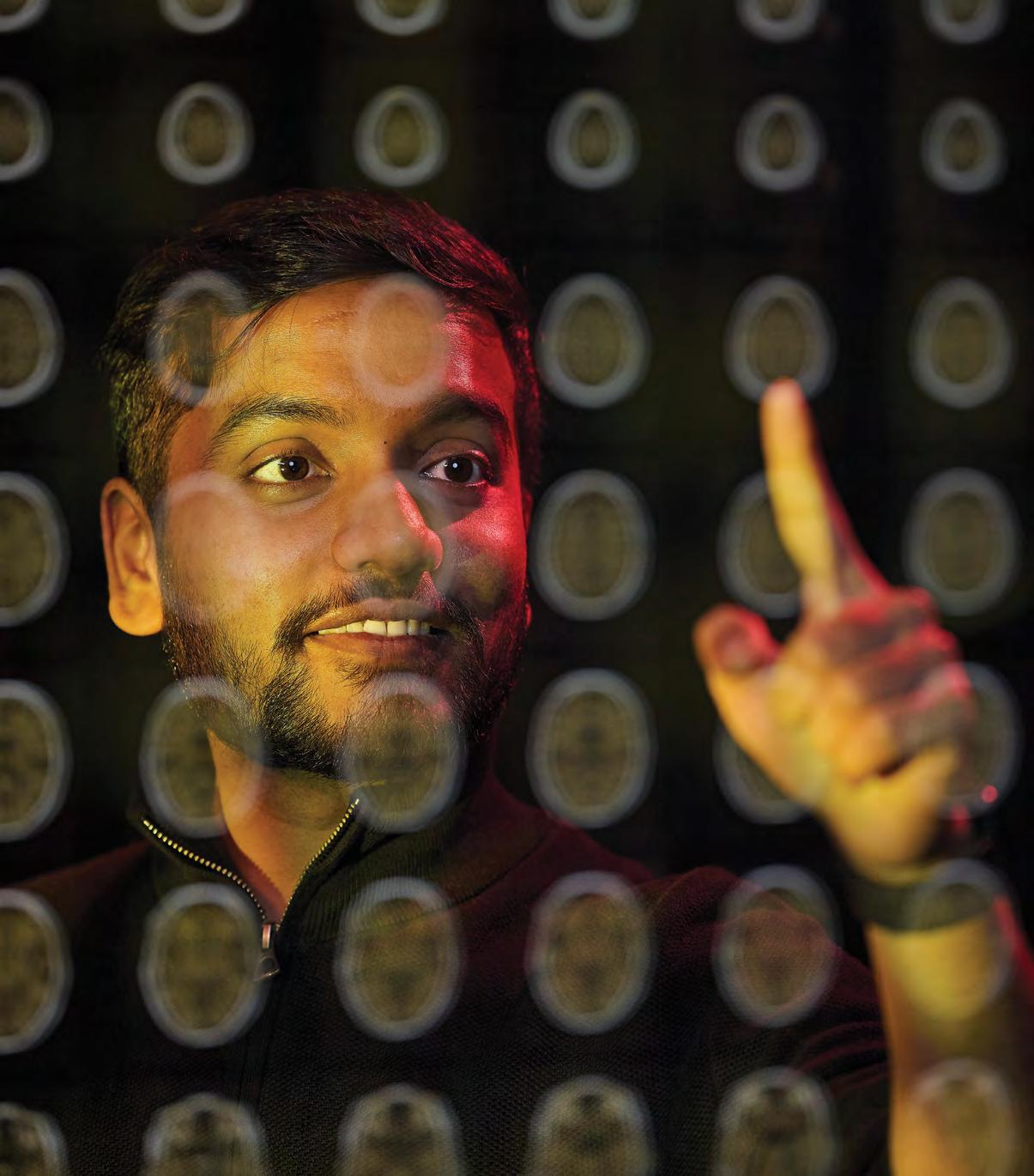
40 S UMMER 2024
PhD student Jay Shah uses AI in Wu’s lab to predict the age of an individual from MRI scans.
then there’s six sessions. So, over six sessions you want to see this virtual patient get better.”
Mapping cancer cells
In the early days of biology, scientists would dissect and examine, peer through microscopes and draw sketches of what they saw.
“It was easy for them to keep in their heads how things work,” says Christopher Plaisier, an assistant professor in ASU’s School of Biological and Health Systems Engineering in the Fulton Schools of Engineering.
Today that’s impossible. We now know there are 25,000 genes in the human genome, and 9,000 of them are expressed in any given cell. The only way to understand the relationships between those genes and how they interact with diseases like cancer is with the help of AI.
Plaisier is trying to build what he calls “intelligible systems.” These AI models will classify different types of cells and help scientists understand the underlying biology better.
Techniques like unsupervised learning can find similarities between different cell types and map out the complex genetic pathways that govern their growth. That can unlock exciting opportunities for medicine.
In one strand of work, Plaisier used AI to analyze tumor cells from malignant pleural mesothelioma, a type of lung cancer. By tapping into databases of existing drugs, his team found 15 FDA-approved drugs that could potentially be repurposed to treat this condition.
Another project looks at quiescent cancer cells, which are in a dormant, nonreplicating state
“We’re trying to understand how biological systems work, and that’s going to lead us to a place where we can actually start to make decisions intelligently.”
— CHRISTOPHER PLAISIER, ASSISTANT PROFESSOR IN ASU’S SCHOOL OF BIOLOGICAL AND HEALTH SYSTEMS ENGINEERING
but could start growing again at any time. Plaisier is using neural network-based classifiers to map the cell cycle of these cells, in the hope of finding ways to knock tumors into quiescence so they stop growing, or out of quiescence so they’re more susceptible to chemotherapy.
AI will help researchers make medical discoveries that weren’t possible before, Plaiser says.
“We’re trying to understand how biological systems work, and that’s going to lead us to a place where we can actually start to make decisions intelligently,” Plaisier says. “That’s where machine learning methods can really help us dig in.”
Preventing falls in seniors
For seniors, falls pose a risk that can derail their ability to live on their own. To try to help, ASU Professor Thurmon Lockhart in the School
of Biological and Health Systems
Engineering has added AI to his biomechanics research.
“Traditional fall-risk assessments for seniors don’t always target specific types of risk, like muscle weakness or gait stability,” Lockhart says.
He’s developed a wearable device that goes across a patient’s sternum. It measures body posture and arm and leg movements in real time to monitor fall risk at home. When the risk is deemed to be high, a smartphone app called the Lockhart Monitor can alert the user or a caregiver before someone actually falls.
“This integration allows for real-time customization of individual patient-care pathways, all tracked through a centralized data system and reported to a clinical team to enhance the ability to improve patient outcomes and target highrisk patients to reduce avoidable injuries,” Lockhart says.
Revolutionizing medicine
These projects represent only some of ASU’s work using AI to make medical breakthroughs.
As sensors get cheaper to make and artificial intelligence tools become easier to use, more medical fields will be able to unlock the power of big data. AI is already helping people receive better care. In the future, it could unlock a golden era of medicine for all. ��
Breaking new ground
Learn more about AI at ASU at ai.asu.edu.
ASU THRIVE MAGAZINE 4 1
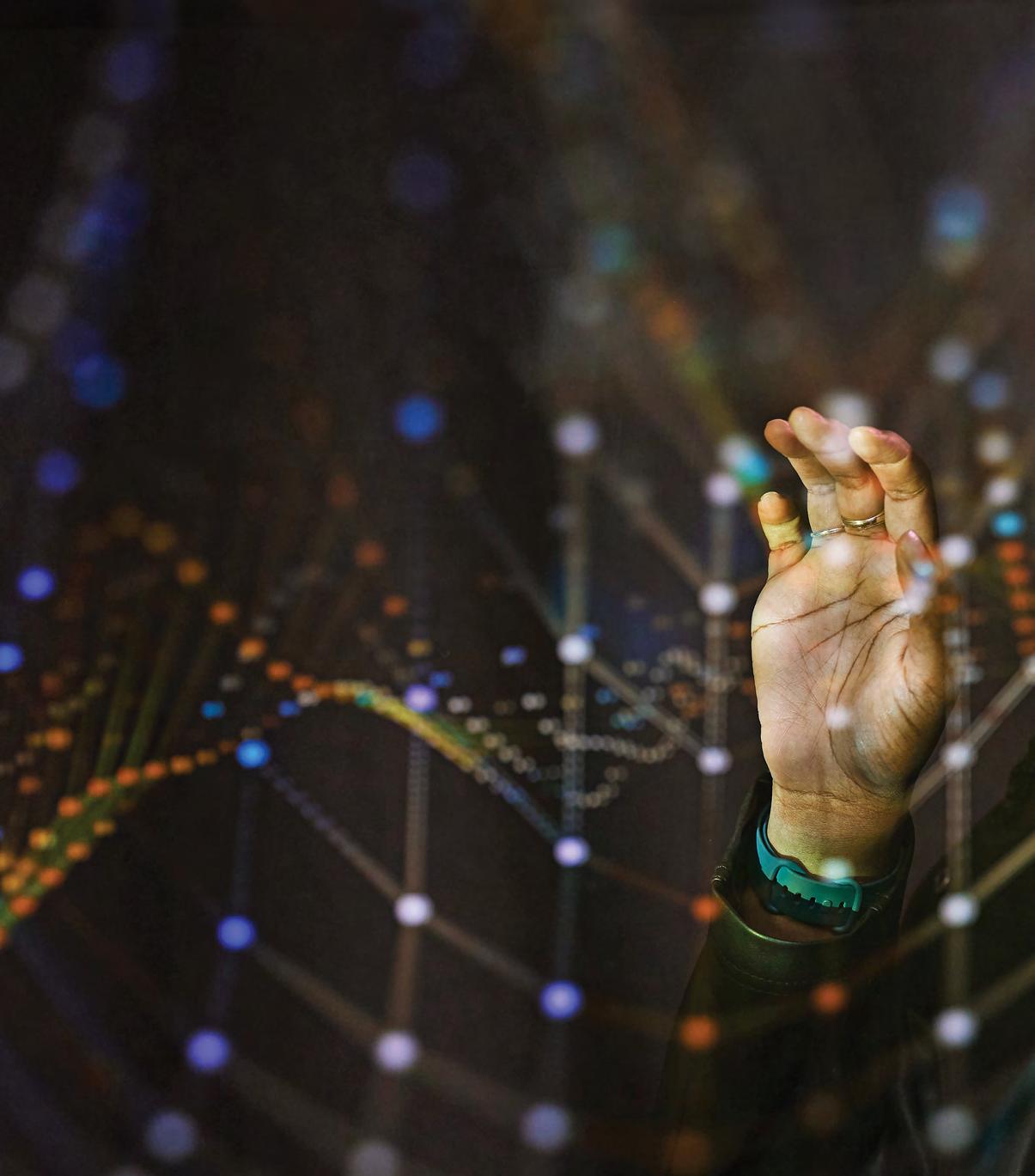
TRANSFORMING EDUCATION
First AI graduate business degree in the U.S.
The W. P. Carey School of Business will be the first business school in the U.S. to offer an AI graduate degree. Faculty members in the Department of Information Systems will begin teaching the Master of Science in artificial intelligence in business this fall.
The program’s goal is to equip leaders with a business-aligned framework and strategies for implementing AI — delivering both technical skills and business skills to design, deploy and apply AI mindfully in diverse business contexts.
W. P. Carey also offers a certificate in artificial intelligence in business, which allows learners to train in the mechanics of this cutting-edge technology, design intelligent systems, learn to harness these systems mindfully for value creation, and then how to embed them into business to transform organizational strategy and revolutionize business processes and operations.
By integrating AI into core educational offerings and providing flexible learning opportunities tailored to various student needs, the W. P. Carey School aims to ensure its graduates are well equipped to fulfill the diverse and evolving career demands in AI-enabled organizations.
Learn more at wpcarey.asu.edu
42 S UMMER 2024
ADVANCE
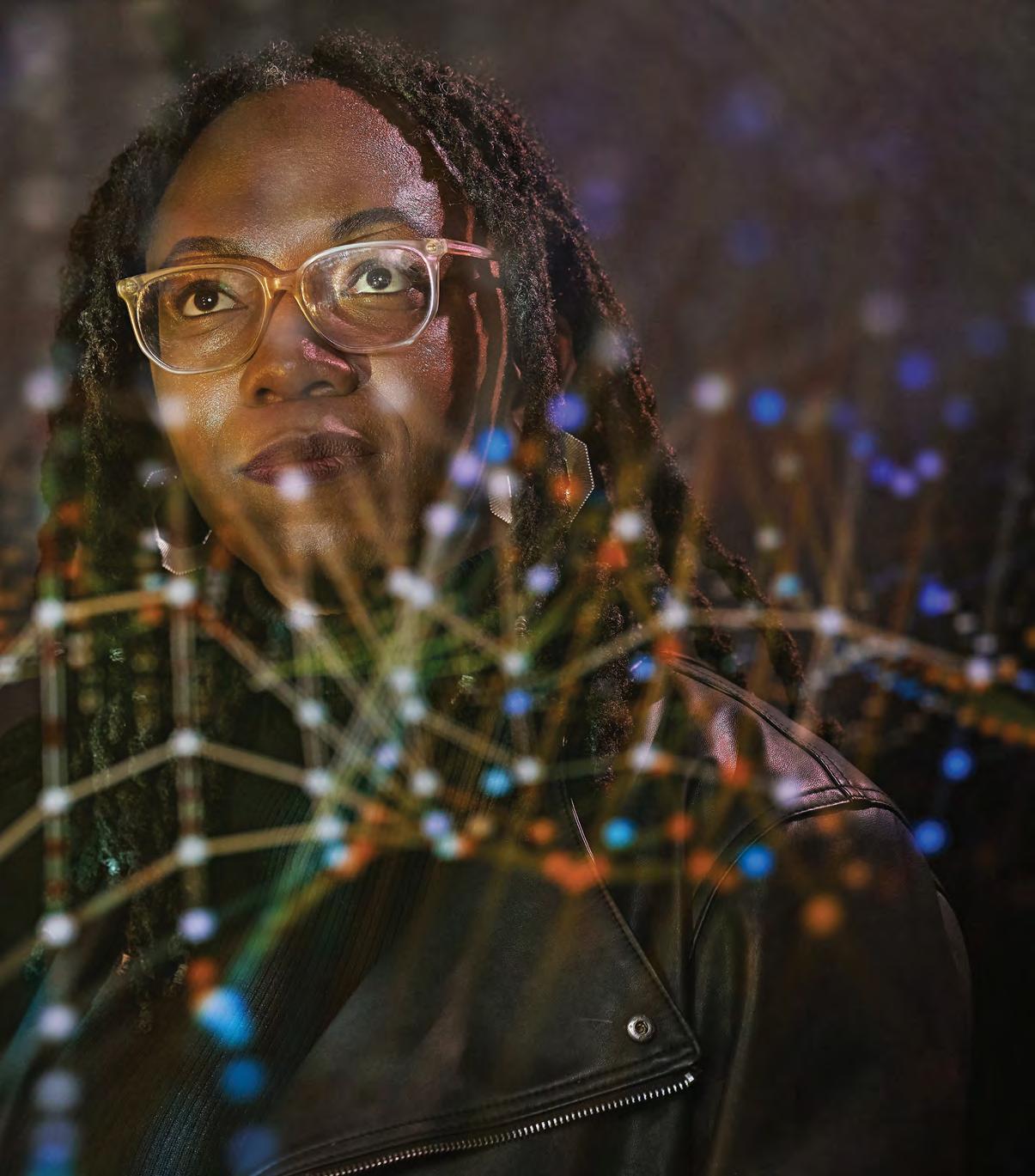
“AI is quickly becoming a vital business skill. We are excited to meet the needs of students and employers through our new graduate degree program.”
— O HAD KADAN, CHARLES J. ROBEL DEAN AND W. P. CAREY DISTINGUISHED CHAIR IN BUSINESS
ASU THRIVE MAGAZINE 4 3
JEFF NEWTON
MBA candidate Catherine Phillips in the W. P. Carey School of Business appreciates the school’s pioneering efforts in AI for business.
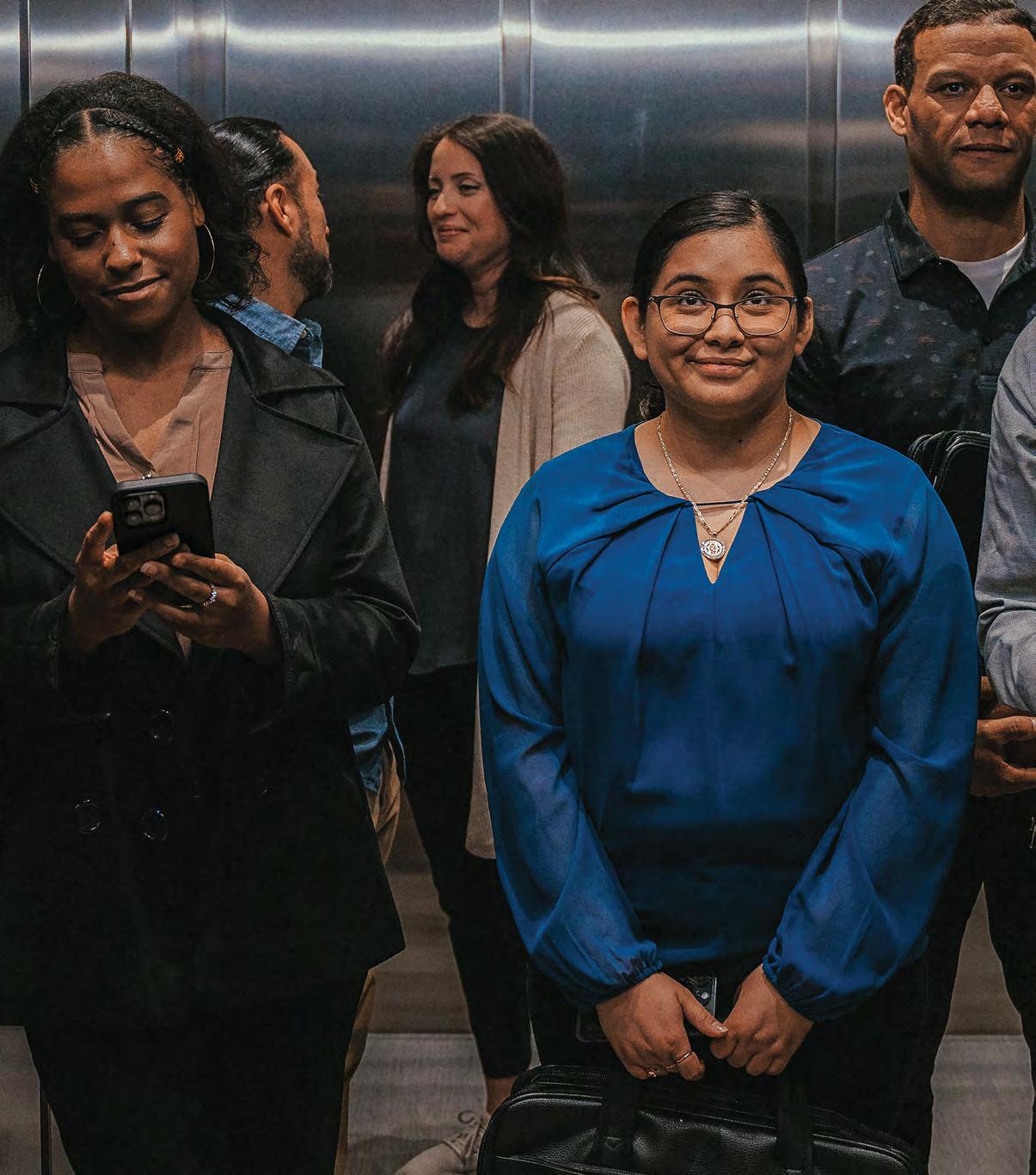
44 S UMMER 2024 ADVANCE

How Cindy Rogel Bahena blazed a trail with help from her mentors
The rise of a at Intel
first-gengraduate
Story by JENNIFER KITE-POWELL
Photos by TODD MACMILLAN
n an overcast day in Oregon in 2021, Cindy Rogel
Bahena, ’21 BSE in materials science and engineering, walked into Intel’s Aloha Factory Operations Far Back End factory to start her day as a wafer fabrication process engineer on the quality control and manufacturing floor.
Rogel Bahena works on a team that creates the tools to develop advanced, tiny semiconductor microchips 10 years into the future.
“I love my work because I help create measurements and a new system of management of projects
and work with other technicians to create the best protocol and bring the highest quality for products across the world,” Rogel Bahena says.
“I create recipes on the tool and work with the automation to implement and ensure that if any troubleshooting is needed, it’s communicated effectively through procedures that I write,” she says. Semiconductors power devices around the world. Everything that switches on and off uses a semiconductor of some kind. Some of the most complicated electronics, like many computers and phones, use Intel’s chips.
ASU THRIVE MAGAZINE 4 5
The road to Intel
At a young age, Rogel Bahena knew she wanted to do something that would impact her community and help the world become a better place.
“I heard ‘engineer,’ and it sounded fun, so I gave it a shot,” she says.
Rogel Bahena is the oldest of seven siblings and the first in her family to go to college. She graduated with honors. English was not her first language and she had no Latina role models to use as examples of engineers, but ASU helped support her in her goals.
Rogel Bahena first connected with ASU when she was at Barry Goldwater High School, not far from the Tempe campus. The Joaquin Bustoz Math-Science Honors Program is a math camp created to help talented students from underrepresented groups gain credits and support for college-level math. Selected students in the top 5% of their class can participate in the summer camp program with a scholarship. With the other students, Rogel Bahena attended classes for college credits on the Tempe campus with professors and tutors.
“I lived on campus for three summers and met so many other engineers, former ASU staff and
Learn more about the MathScience Honors Program at mcmsc.asu.edu
Learn more about the Society of Hispanic Professional Engineers at studentorgs.engineering.asu. edu/shpe
alumni with similar backgrounds,” she says.
“This experience made me feel comfortable about the transition to college, and it was the right space for me to grow with a community of highly excelling students,” Rogel Bahena says. “Because of this experience, there weren’t any other serious college considerations for me because I already had a built-in community at ASU.
“Now, I am a tutor in the program from afar,” she says.
Seeking help
Rogel Bahena says a key to her success is her relationships with mentors, both now and during college. One impactful experience, she says, was talking with Professor Seth Tongay, chair and professor of materials science and engineering at ASU, who told her she was indeed smart enough to become an engineer — never to doubt that — and helped provide extra tutoring so she could master the math and engineering concepts.
Meanwhile, Carrie Robinson, executive director of graduate student and scholar success, helped provide Latino role models, Rogel Bahena says.
“Women and Latinos are underrepresented in STEM,” Robinson says. “Because Latinas are less likely to see people who look like them as students in their classes, as instructors and in industry, it’s important to be deliberate about how we as university faculty and staff make those connections.”
Mentors at ASU share their experiences, offer


46 S UMMER 2024


“There has to be a lot of kindness, coaching and feedback in engineering because nobody knows what this stuff is and no one has done it before.”
— CINDY ROGEL BAHENA, ’21 BSE IN MATERIALS SCIENCE AND ENGINEERING
advice for success and provide encouragement when underrepresented students hit challenges and barriers, Robinson says.
While at the university, Rogel Bahena joined the Society of Hispanic Professional Engineers student chapter, which she served as president.
“Having people with the same background as me and the mentorships made me feel at home at ASU,” Rogel Bahena says, as did soaking up the knowledge from professors of all backgrounds.
She says she possesses an impressive set of lab skills because of faculty mentors like Shahriar Anwar, research specialist senior in the School for Engineering of Matter, Transport and Energy.
Working together
Collaboration is critical at Intel, and she says her time in the ASU labs developed her collaborative skills.
“When we do lab work at Intel, we’re working with other people on technology that hasn’t come out yet. There has to be a lot of kindness, coaching and feedback in engineering because nobody knows what this stuff is and no one has done it before,” she says. “You have to work together and ask things like ‘Do you think this hypothesis would stand up against the customer’s needs?’”
Rogel Bahena says it was the same at ASU. “You had to quickly learn to set up a collaborative environment in the labs and classes for group projects.”
She emphasized the importance of connecting with others, “because there were so many opportunities at the university. It could be overwhelming, forcing you to share your career aspirations with peers, advisors and professors, and from there, get direction.”
At Intel, Rogel Bahena sometimes goes to colleagues to hear what they know about a subject or problem.
“In my work, I took that experience from ASU and just went and bugged everyone who had been there for 10 to 30 years, and I would ask, ‘How does this work?’ Or, ‘I heard you were the expert on this. This is what I’m trying to do. Tell me more about what you know that can help me solve this,’” Rogel Bahena says.
“Sometimes they would say, ‘I am not an expert but I can teach you what I know,’” Rogel Bahena says. “Honestly, a little secret is that everybody doesn’t necessarily know exactly what they’re doing, so you expect that you are going to find a solution together.”
The bunny suit
Semiconductor engineers working with sensitive materials like chips or wafers wear the white bunny lab suit to prevent particles from contaminating the clean work areas where tiny chips, smaller than the width of a hair, are made. Rogel Bahena loved becoming part of that engineering community — but it took finessing to get into the suit.
“I remember having the hardest time having my long hair fit in a cap.
Top photos: Cindy Rogel Bahena. Bottom: clean room at the Intel fab that requires “bunny suits.”
ASU THRIVE MAGAZINE 4 7

My technical mentor sent me to talk to another female process engineer to learn the tricks of the bunny suit,” she says.
The suit was just part of the awe; she recalls how beautiful and expansive the Ocotillo campus was and the first time she saw a semiconductor fabrication site, or “fab,” as part of one of her internships while at ASU.
“The huge fab was intimidating; everything was big and moved so fast with so many protocols,” she says. “There were lasers and sensors that you couldn’t even stand in front of or near since you would trigger an alarm. It was unlike anything I had ever seen before.”
On her first day in her bunny suit at Intel, she said she was lucky enough to see a whole wafer mid-process.
“It was impressive and overwhelming but an amazing feat of human intelligence,” she says.
Inspiring others
From awkward bunny suits and working at Intel to building out her skills in the lab, Rogel Bahena feels like a trailblazer.
“I was the first in my family to graduate — and with honors, a degree, two certifications and other designations with full-ride scholarships,” she says. “I want to be a role model for Latinas who
Top engineering talent
The Ira A. Fulton Schools of Engineering is the largest and most comprehensive engineering school in the nation, offering 25 undergraduate degree programs and 50 graduate degree programs
6K new engineers per year
Number of new engineers graduating annually from the Fulton Schools by 2025
$145M research expenditures in the Fulton Schools in FY22
316 patents in the last three years in the Fulton Schools
33 NSF CAREER awardees in the last three years among faculty in the Fulton Schools
SOURCE: IRA A. FULTON SCHOOLS OF ENGINEERING
follow in my footsteps.”
As part of her purpose to give back, she translates what engineers do at Intel’s STEM events in local elementary schools. She also uses Spanish to communicate with parents at summer camps sponsored by Intel, where she volunteers as a counselor.
“I was always the quiet engineer learning to speak up for myself and trying to learn to be an extrovert. Seeing the diverse population at ASU with a wide range of interests allowed me to learn and adapt to pursue my different goals in my college years and in my role at Intel today.” ��
Learn more at engineering.asu.edu
48 S UMMER 2024
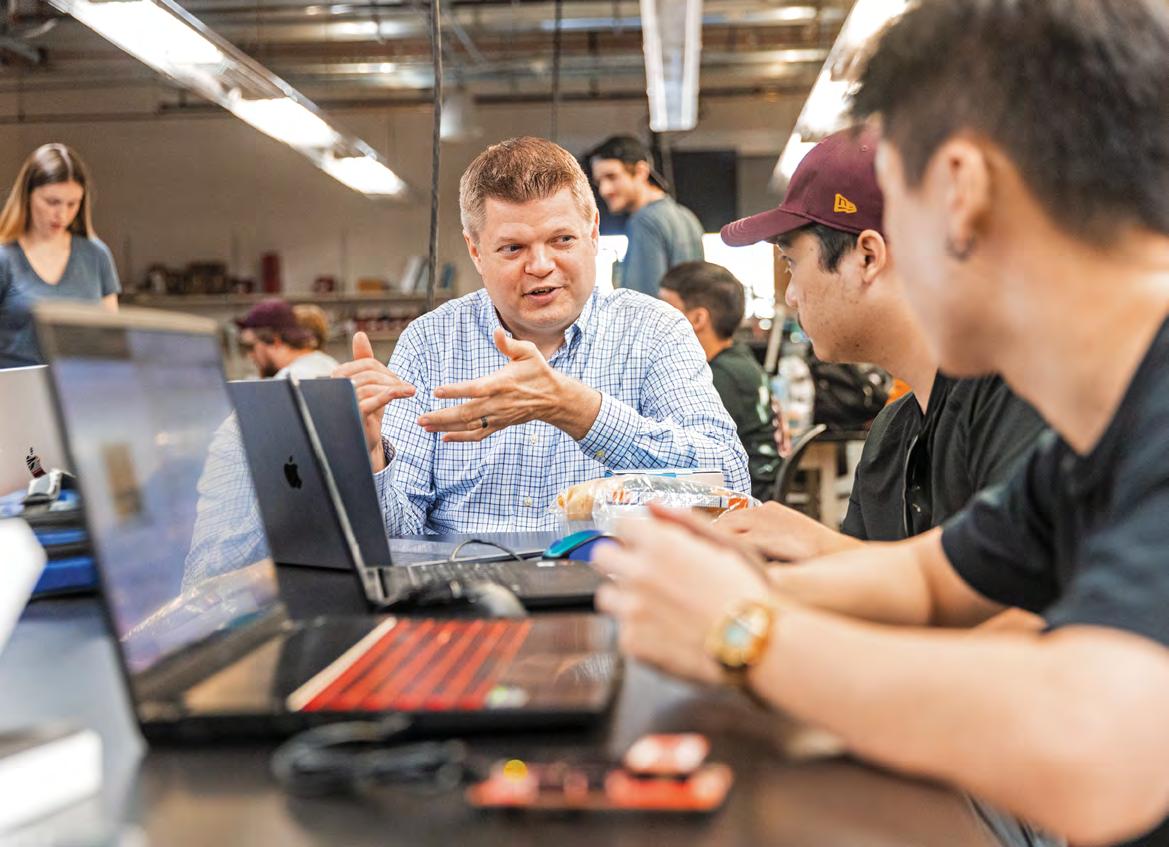
Q&A with the new leader of engineering at West Valley campus
Associate Professor Shawn Jordan is taking the helm of the newest school in the Ira A. Fulton Schools of Engineering
What makes the School of Integrated Engineering different from other engineering schools?
We listened and designed a new school that meets the needs of today’s learners and industries. Our world needs more engineers and too many students think they don’t have what it takes. We’ve redesigned the curriculum everything from the math and science requirements to adding the flexibility to fuse engineering with a concentration of your choice, like business or microelectronics. We’re opening the door to more future engineers, and at the same time producing graduates with the skills today’s high-tech West Valley employers need.
Why launch the school in the West Valley?
The West Valley is already home to many engineering and tech employers, with massive growth and investment on the horizon. That’s one of the main reasons ASU wants to help bring engineering here. We want to support current and future students to study engineering close to where they live and make an impact in their communities.
How will the new school work with West Valley communities?
One of my aspirations is to establish diverse academic programs that reflect the needs of the community. A big part of that requires active partnerships with companies that are already in the area. We’ll also be engaging West Valley middle and high school students through STEAM Labs.
Enrolling for Fall 2024
Go
to
learn more. ASU THRIVE MAGAZINE 4 9 SABIRA MADADY/ASU ADVANCE
sie.engineering.asu.edu to
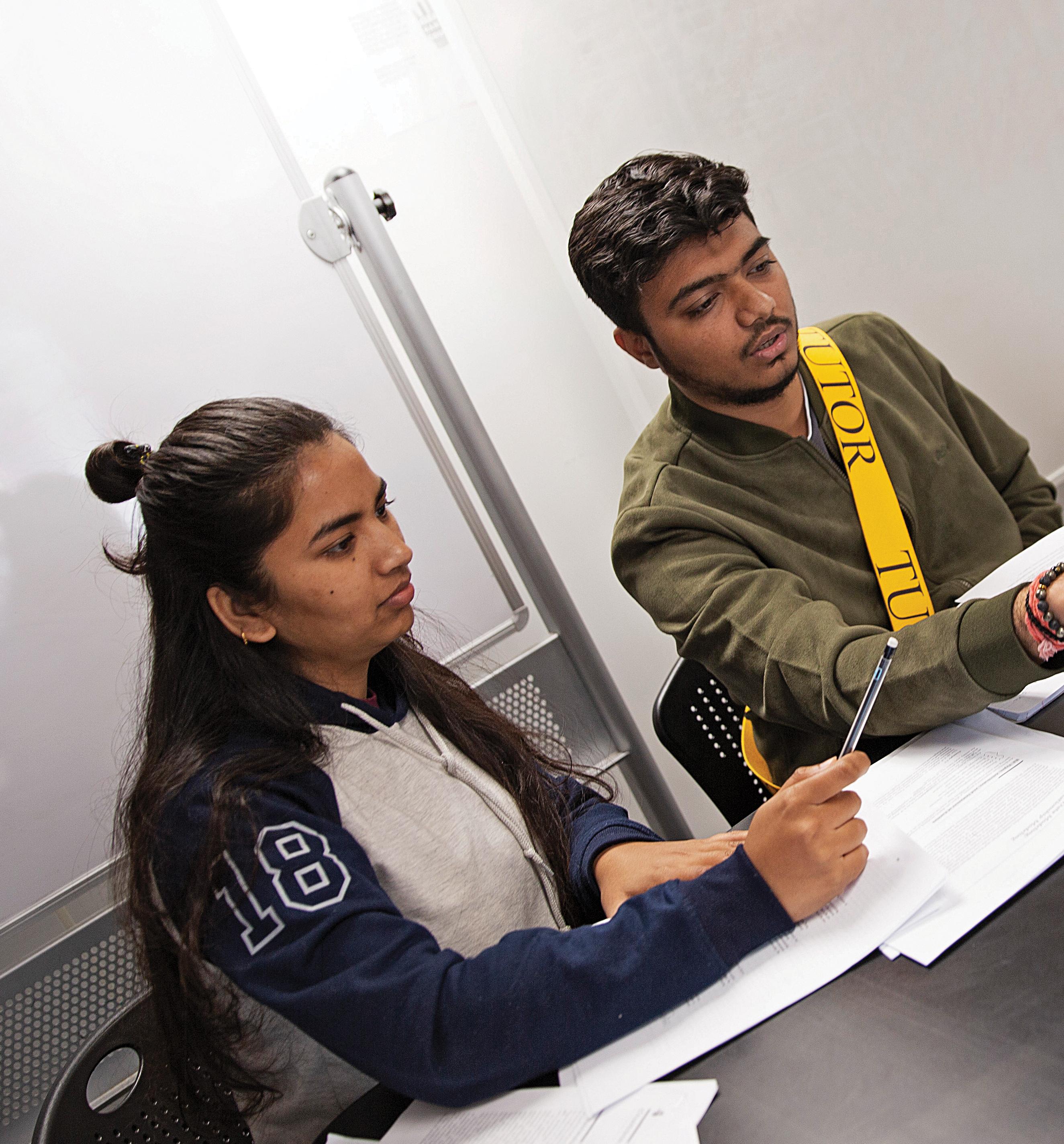
“It is another example of our strong effort to promote inclusive excellence and broaden access to workforce pipelines.”
— KYLE SQUIRES, ASU SENIOR VICE PROVOST FOR ENGINEERING, COMPUTING AND TECHNOLOGY AND DEAN OF THE FULTON SCHOOLS
ADVANCE
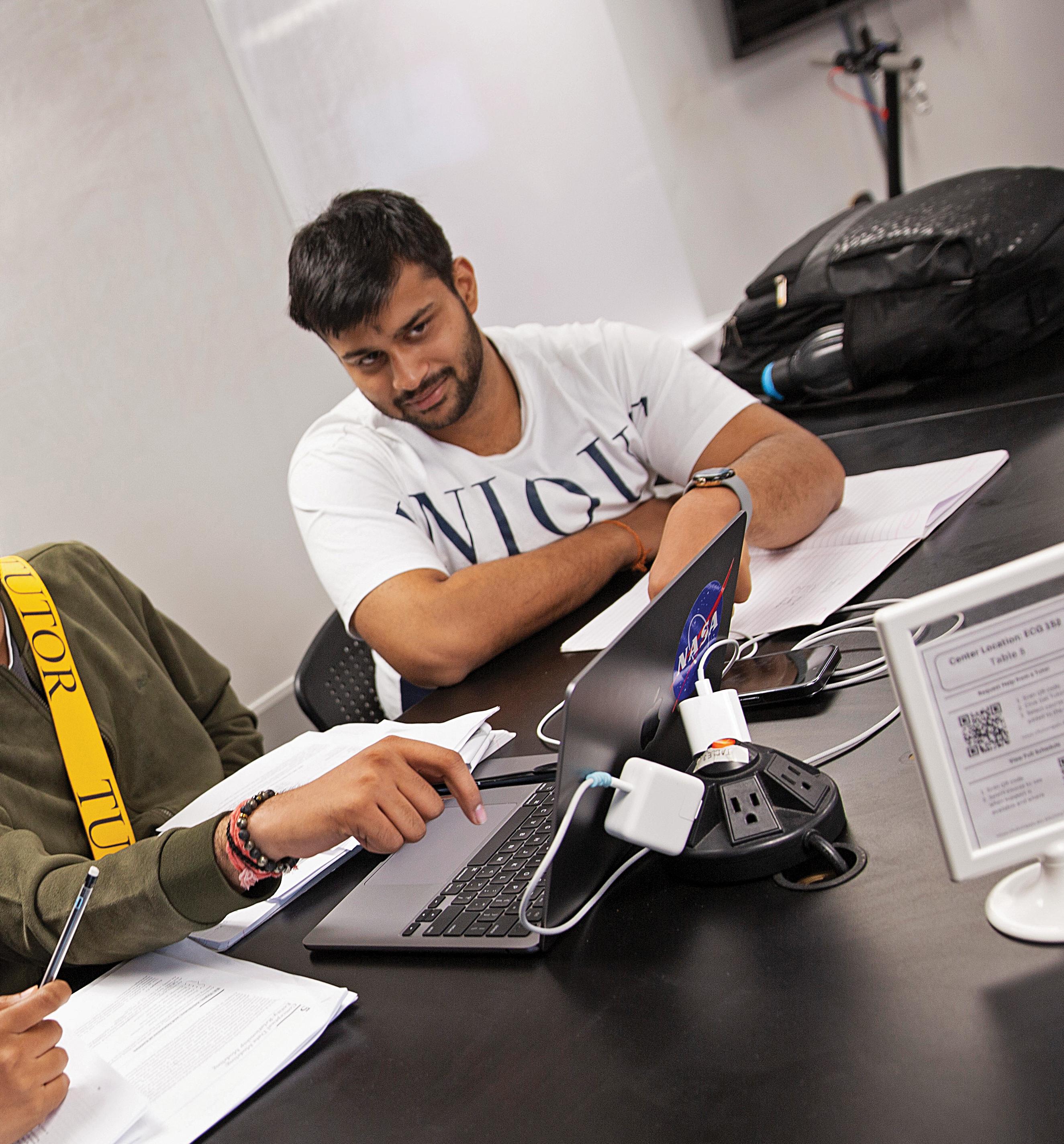
ENSURING STUDENT SUCCESS Intel grant supports personalized tutoring for engineering students
Intel, one of the world’s largest semiconductor producers, is working within the Ira A. Fulton Schools of Engineering to promote student success and excellence in semiconductor workforce development. Through a new grant from Intel, first-year students will receive individualized tutoring for MAT 265: Calculus for Engineers I, a required course that is a significant predictor of retention in STEM studies.
The funding also will increase opportunities for students to participate in existing programs, including the Fulton Undergraduate Research Initiative and the Master’s Opportunity for Research in Engineering, and provide other specialized training.
Learn more at engineering.asu.edu .
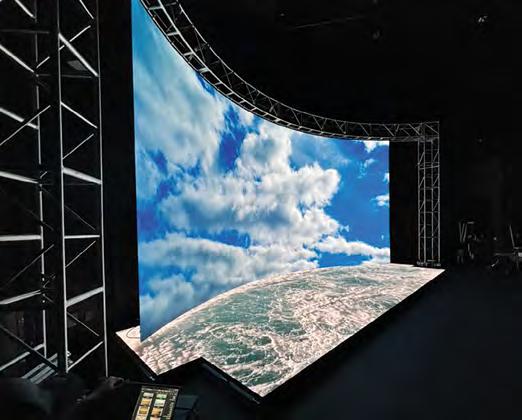
HOLLYWOOD TECH
ASU is teaching virtual production tech used in ‘The Mandalorian’
The MIX Center in downtown Mesa is capable of producing anything from blockbuster superhero movies to virtual reality video games — and teaching students the skills they need for a digital economy. The newest addition is Planar virtualproduction technology with high-resolution LED wall and floor screens, technology also available at the ASU California Center in LA.
The technology was used in “The Mandalorian,” as well as in “Dune” and “The Batman.”
The environments are created digitally and loaded onto the giant screens, where the actors can interact with what the audience will see. Previously, actors worked in front of a blank green screen and the digital effects were added during postproduction. The new method streamlines the preproduction, production and postproduction timelines.
Because ASU is one of the only film schools offering the technology, faculty members are helping to set standards for teaching the method. Learn more at herbergerinstitute.asu.edu .

52 S UMMER 2024
“Actors
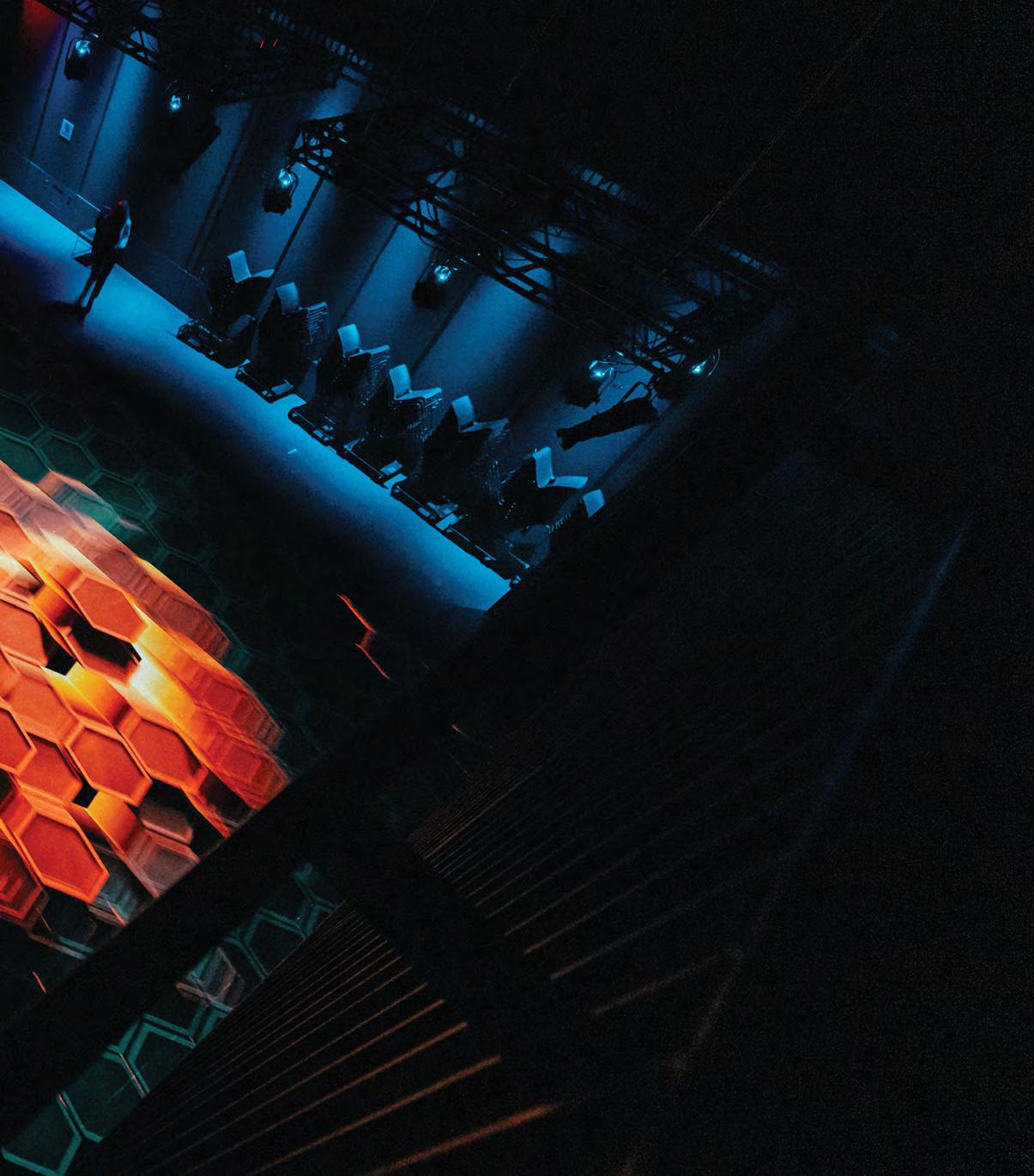
The MIX Center in downtown Mesa offers 8,100 square feet of professional quality soundstages with acoustic isolation, an automated lighting grid and advanced camera systems.
ASU THRIVE MAGAZINE 5 3 HENRY BEACH/ASU; KYLE GILBERT
Arts
Ticket to fashion Page 54
can see the environment and respond to it.”
JAKE PINHOLSTER, FOUNDING DIRECTOR, MIX CENTER AND EXECUTIVE DEAN, ASU HERBERGER INSTITUTE FOR DESIGN AND THE ARTS
—

This spring, 40 ASU FIDM students boarded a charter bus in Phoenix for a three-day, two-night fashioncentric trip to Los Angeles to experience ASU FIDM in LA.

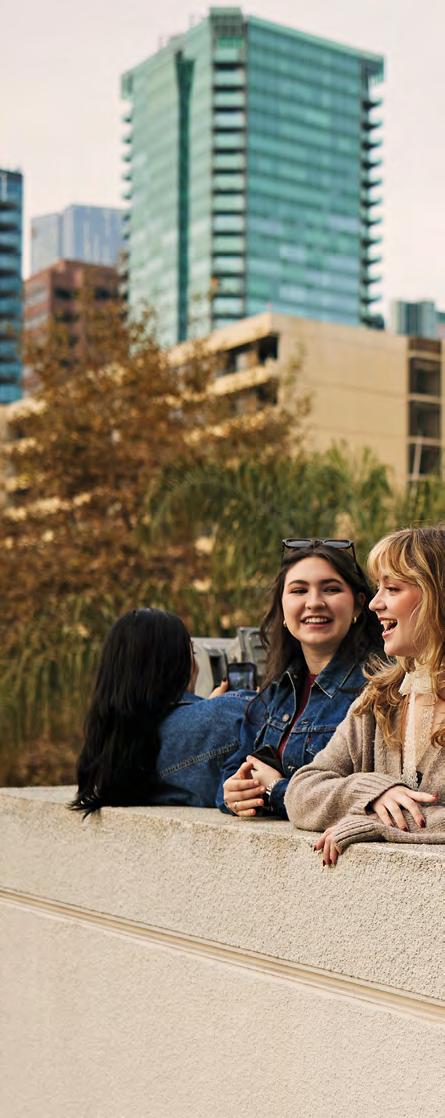
54 S UMMER 2024
ASU FIDM students walk through the Fashion District in downtown LA.
ARTS
ASU FIDM students arrive in LA. Remington Reble, program manager for ASU FIDM, was the key organizer of the trip, which will be an annual event.
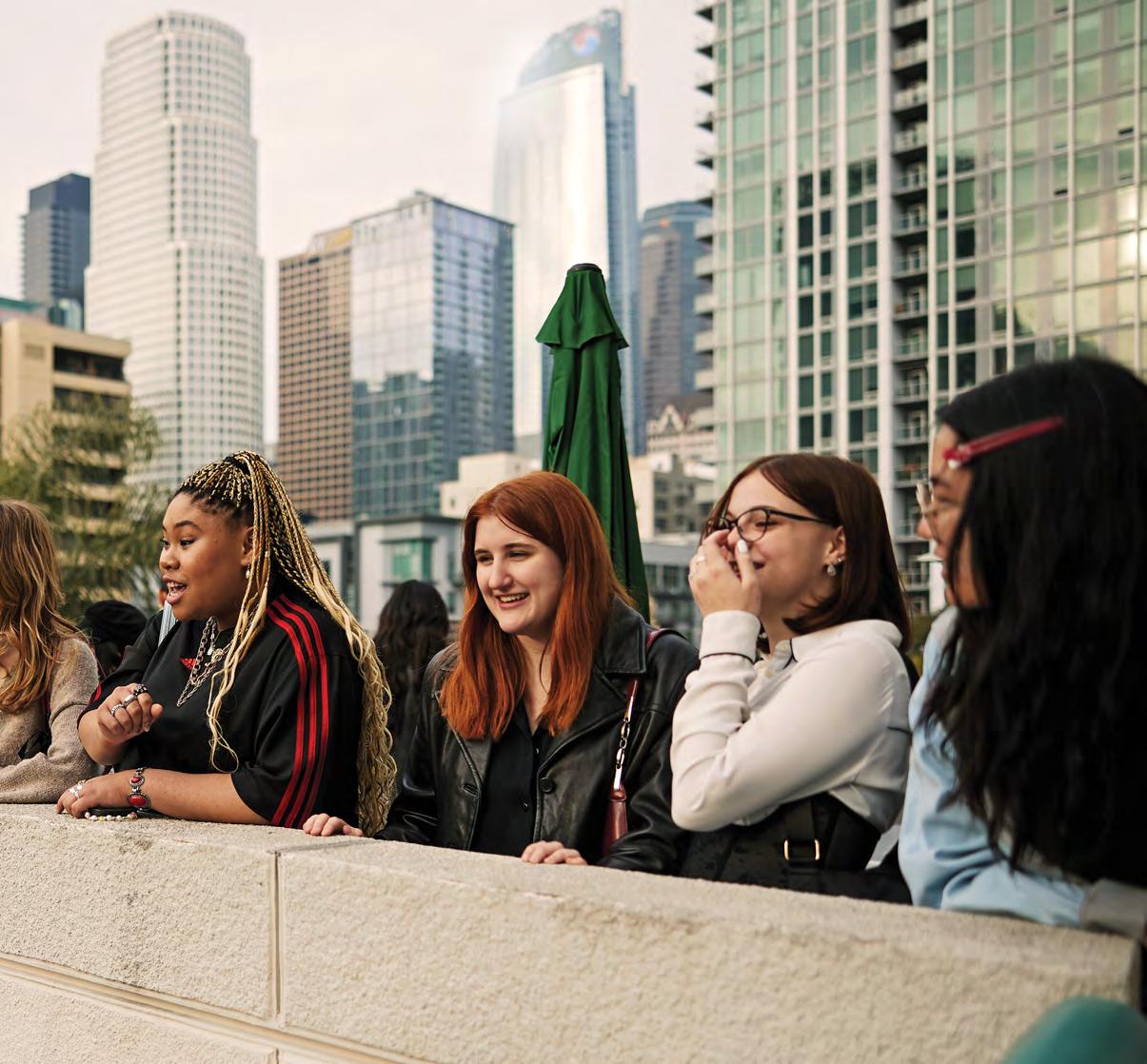
Phoenix ASU FIDM
road-trip to LA Ticket to Fashion
ASU THRIVE MAGAZINE 5 5
Story by DEBORAH SUSSMAN Photos by DERREN VERSOZA
students
ASU FIDM students look over downtown Los Angeles from the balcony of the ASU California Center Grand building.

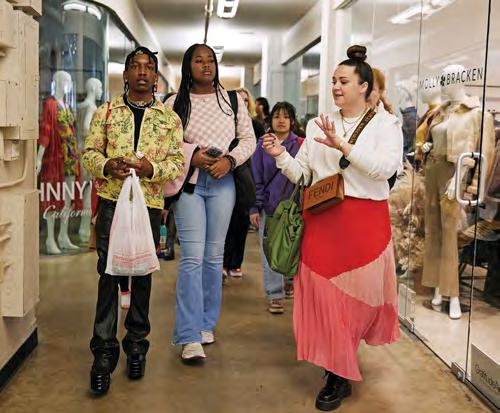
The organizers hope the inaugural trip will be the first of many, and that going forward, the PHX–LA trips also will include students from the Sidney Poitier New American Film School and the Design School.
Like ASU FIDM, both the film school and the Design School also operate in LA.
While there, the students took an in-depth tour of the ASU California Center Grand building. The tour included a demo of the Textile Testing Lab with Professor Deborah Young, a tour of the ASU FIDM Library and its unique resources by Jennifer Blue, and
a showing of the ASU FIDM Museum Study Collection by curators Christina Johnson and Christina Frank.
That evening, approximately 80 ASU FIDM faculty, staff and students got together for a mixer complemented by a DJ set from Shaun Samson, a faculty member in ASU FIDM.
The next morning, ASU FIDM hosted costume designer B. Åkerlund, a frequent collaborator with Beyoncé, Madonna and Lady Gaga, for a lecture attended by approximately 75 students, faculty, staff and community members.
56 S UMMER 2024
Moriah Robinson, founder of The Textile Show, gives ASU FIDM students a behind-the-scenes tour of fashion showrooms at the New Mart in downtown LA. Showrooms are spaces dedicated by brands to preview an upcoming fashion collection.
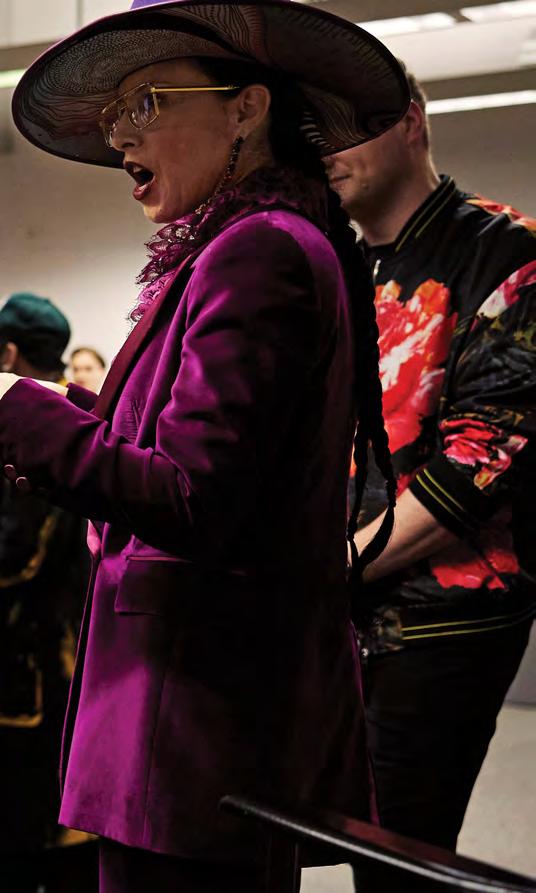
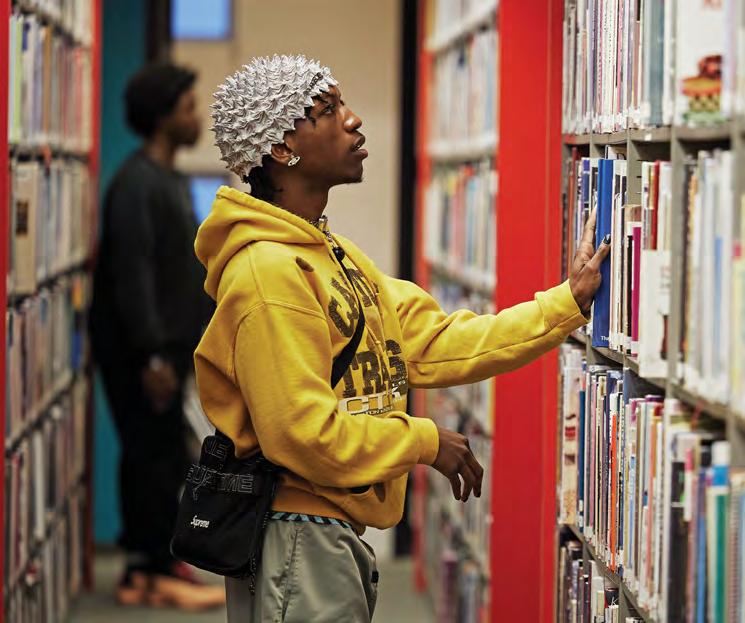
B. Åkerlund, an esteemed fashion activist who has designed costumes for Beyoncé, Lady Gaga and Madonna, speaks with ASU FIDM students following her lecture at ASU California Center Grand.
“I would never have been able to experience something like this if it weren’t for ASU FIDM.”
— RILEY KENNEDY, FASHION STUDENT AT FIDM

ASU FIDM students get hands-on experience with archival garments. Pictured: motorcycle jacket and skirt by Gianni Versace, circa 1995, a gift from Dorothy Washington Sorensen to the ASU FIDM Museum Study Collection.
ASU THRIVE MAGAZINE 5 7
ASU FIDM student Dejuan Russell investigates the Fashion Library at ASU California Center Grand.
ASU FIDM students shop for fabric in the LA Fashion
District.
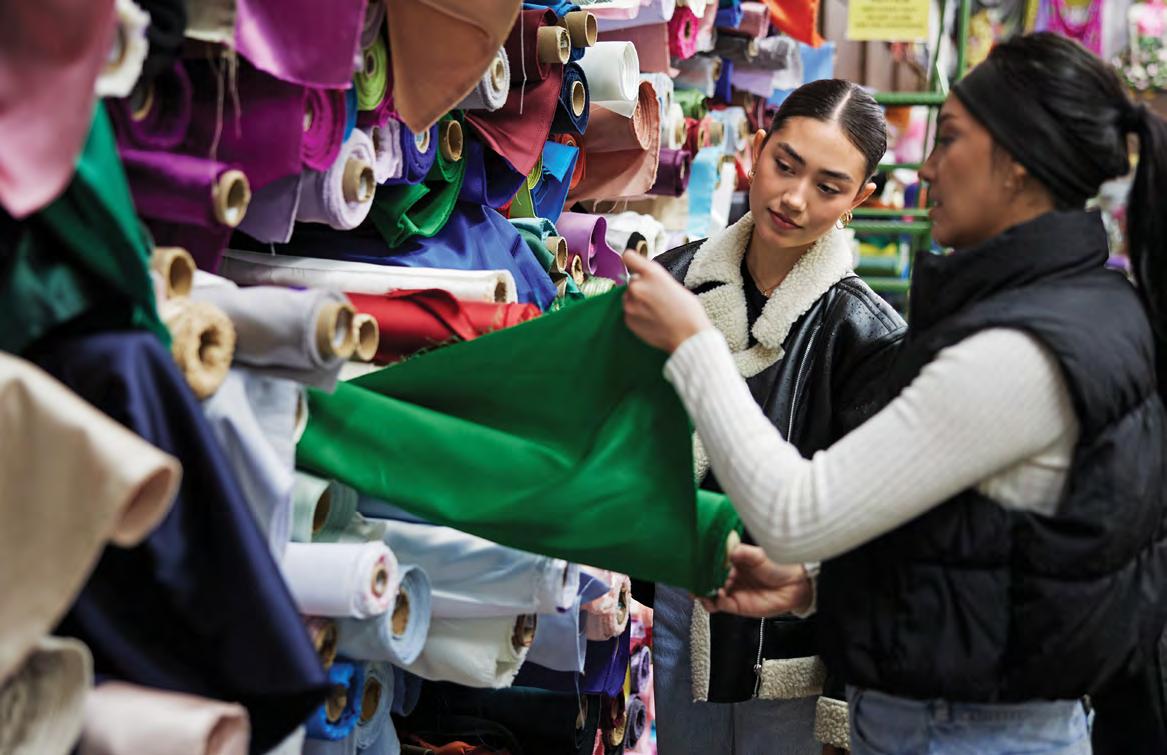
“ This trip was not only a great opportunity but also so fun. It was such a cool learning experience and also allowed us to make connections within the LA fashion industry.”
— RILEY KENNEDY, ASU FIDM STUDENT
In the afternoon, the ASU FIDM Phoenix students took tours of the premier showroom locations in the LA Fashion District, including the Cooper Design Space and The New Mart.
On the final day of the trip, the visiting students from Phoenix went fabric shopping in the Fashion District, led by ASU FIDM faculty chaperones who guided the students for their upcoming projects.
“I’m super appreciative of all the work put into this trip and how
many people took the time to help us students,” ASU FIDM student Riley Kennedy says. “This trip was not only a great opportunity but also so fun. It was such a cool learning experience and also allowed us to make connections within the LA fashion industry.
“I would never have been able to experience something like this if it weren’t for ASU FIDM,” Kennedy says. “I hope other students will also be given this opportunity in the years to come.” ��
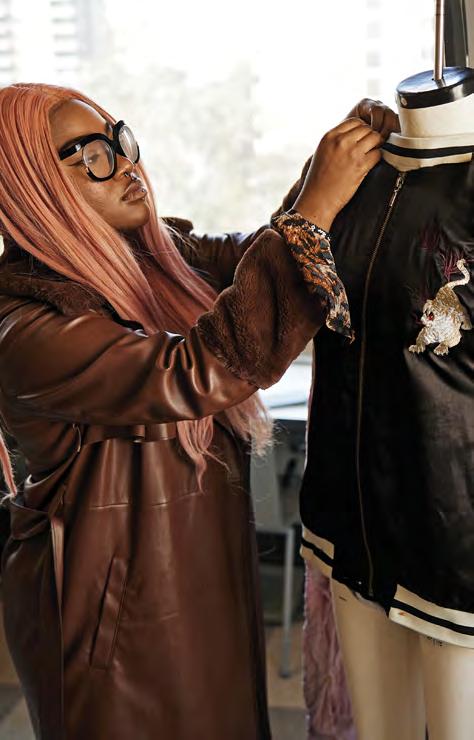
58 S UMMER 2024
Ehethe Hassan pins ribbing on the jacket she designed and constructed.
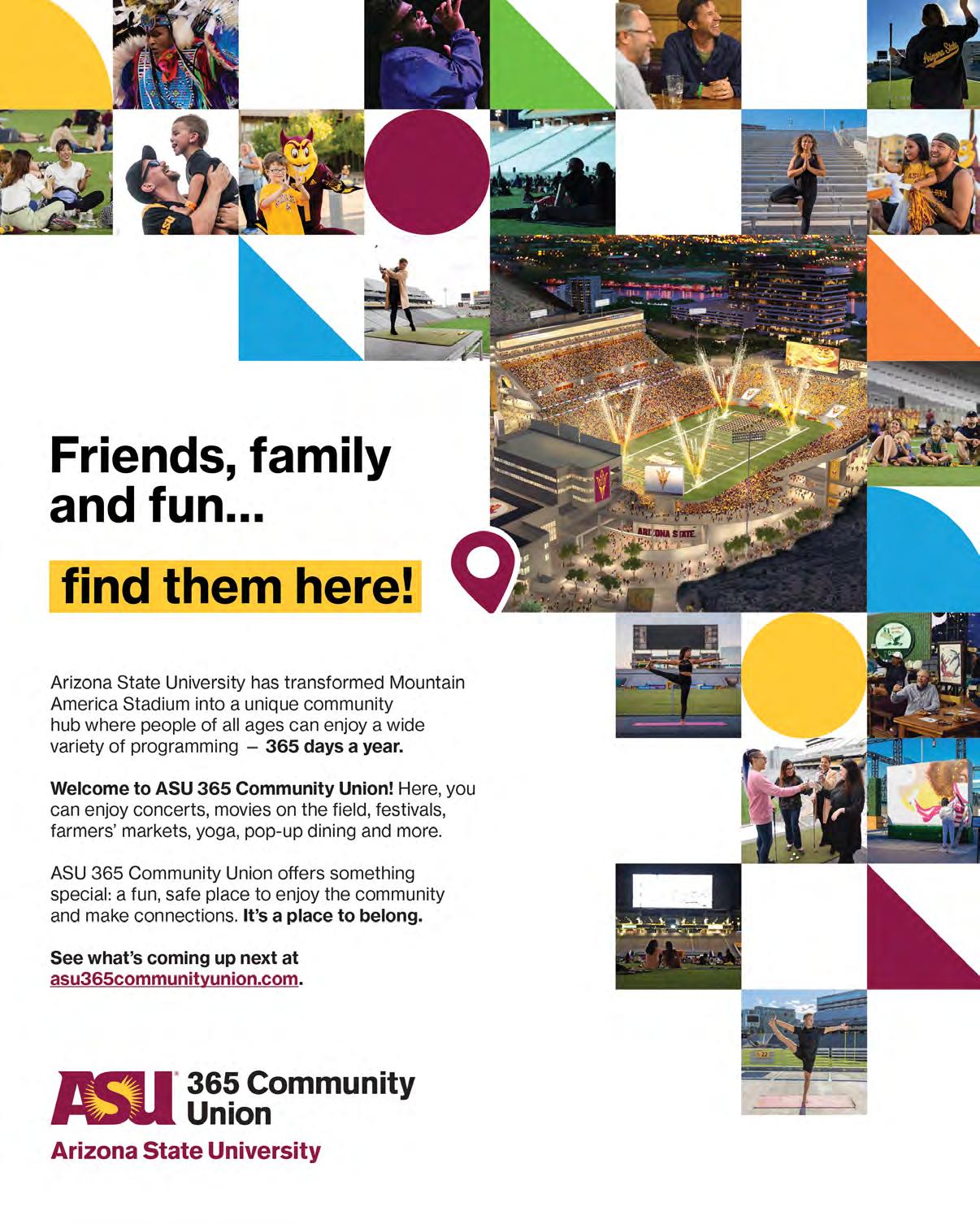
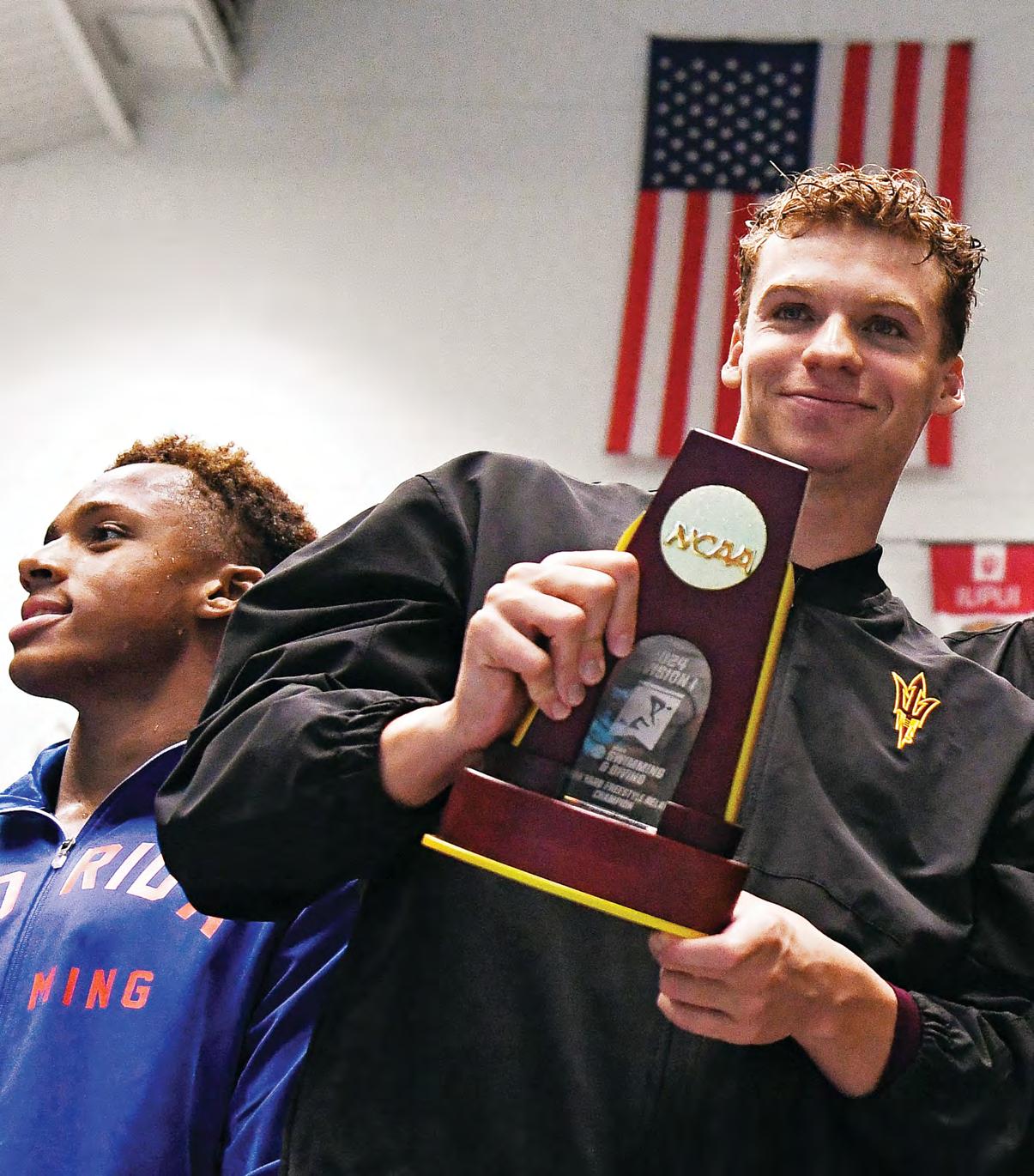
NATIONAL CHAMPIONS
Sun Devil Men’s Swim and Dive team dominates the NCAA Championship — and Léon Marchand eyes Olympic gold
Sun Devil Men’s Swim and Dive are NCAA champions for the first time in program history. The Sun Devils won seven events throughout the competition week en route to the championship.
Nine school records fell throughout the four-day competition, along with three NCAA records. Additionally, 14 Sun Devils received All-American honors throughout their time at the meet.
The 400 free relay team of Léon MarchandJack Dolan-Patrick Sammon-Jonny Kulow went out with a bang as they broke the NCAA record with a time of 2:43.40 to win the relay.
Léon Marchand won the 200 breast title for the third year in a row, taking the event with a time of 1:46.35, breaking his NCAA record set at last year’s championship. With his win in the 200 breast, Marchand now leads all Sun Devils ever with individual titles with eight.
Marchand is expected to contend for multiple medals at the Olympics in his home country of France.
Learn more at thesundevils.com/sports/ mens-swimming-and-diving .
60 S UMMER 2024
The NCAA title-winning 400 freestyle relay team of (from left) junior Léon Marchand, graduate student Jack Dolan, sophomore Jonny Kulow and junior Patrick Sammon.
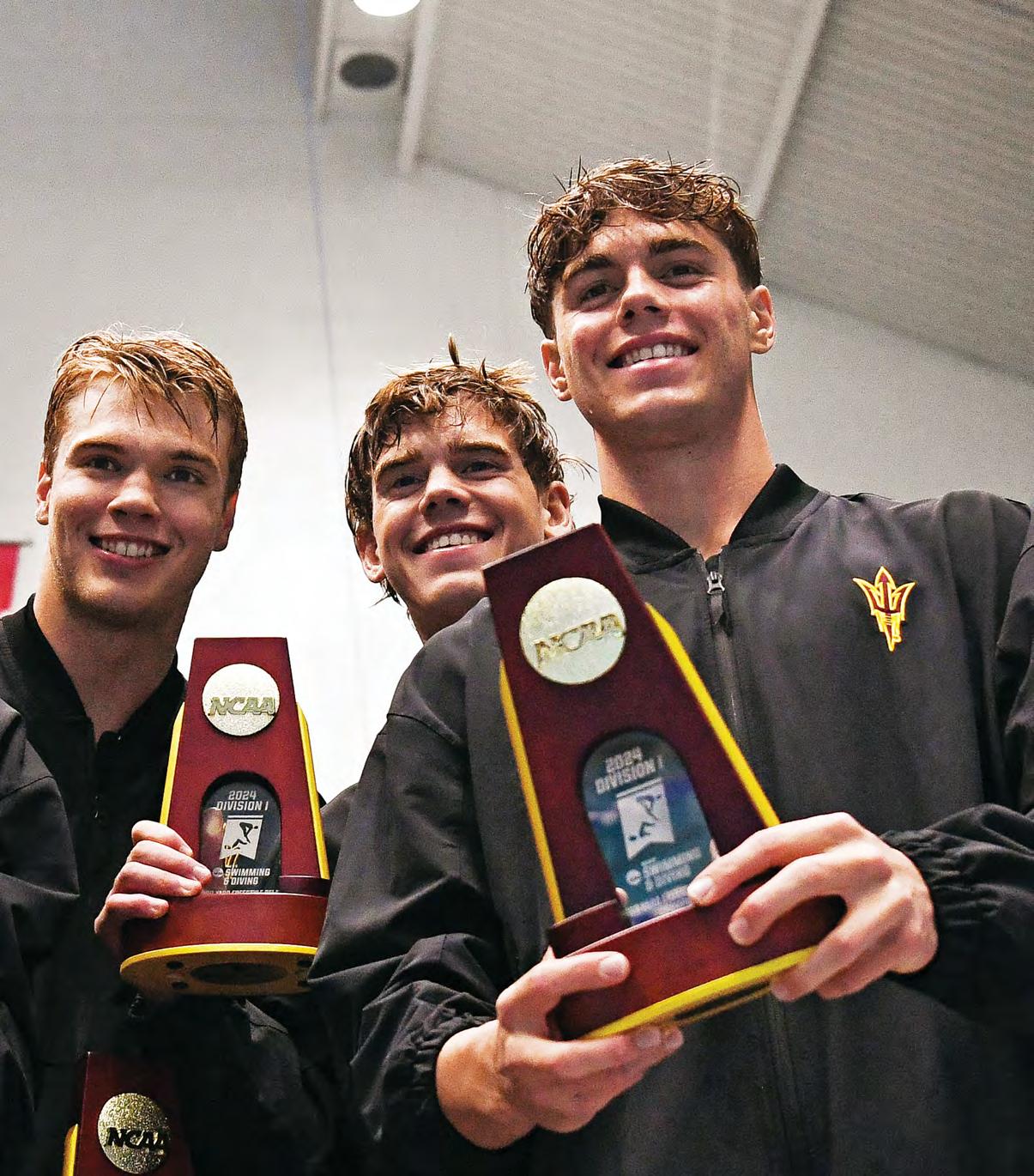
ASU THRIVE MAGAZINE 6 1
Former baseball player inducted into hall of fame
Page
63
Page
MIA JONES/ASU
50 Sun Devils added to academic honor roll
63 Sports






The Sun Devils’ first year in the Big 12 will be a new chapter for athletes and fans. Join the team for an elevated home game experience.
August 31 vs. Wyoming
September
7 vs. Mississippi State
12 at Texas State
21 at Texas Tech
October 5 vs. Kansas
11 vs. Utah
19 at Cincinnati




November 2 at Oklahoma State
9 vs. UCF
16 at Kansas State
23 vs. BYU
30 at Arizona
Big 12
Big 12
Big 12
Big 12
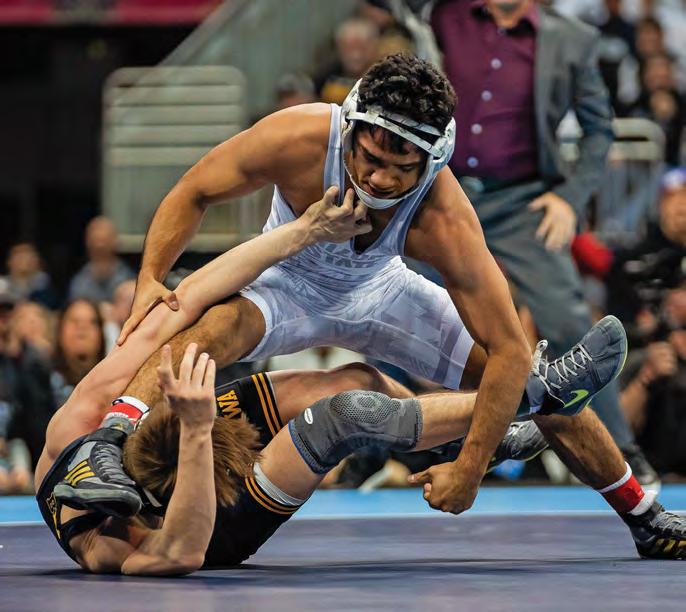
Wrestler wins national championship
Big 12
Big 12
Big 12
Big 12
Big 12
Visit thesundevils.com for athletics event and ticket information.
Join a tailgate in Tempe or with your local chapter by connecting at alumni.asu.edu/events/gameday.
Family Ticketed
In March, Sun Devil Wrestler Richard Figueroa took first place at the 2024 NCAA Division I Wrestling Championships. The 125-pounder couldn’t be stopped all weekend, rattling off five wins from Thursday through Sunday to reach the top of the podium, making his way past No. 25 Ethan Berginc (Army), No. 9 Patrick McKee (Minnesota), No. 1 Braeden Davis (Penn State), No. 12 Anthony Noto and No. 3 Drake Ayala (Iowa).
Sun Devil Wrestling finished sixth overall. It’s the first time a Sun Devil wrestler has taken the top spot since 2019.
Follow wrestling at thesundevils.com/sports/wrestling.
Get ready for Gameday VS 2024 Football Schedule
62 S UMMER 2024 SU N DEVIL ATHLETICS SPORTS
First-year student golfer’s 27-under win sets records
At the 2024 Amer Ari Invitational in Kamuela, Hawaii, first-year student Wenyi Ding posted a score likely to stand for a long time. Ding won the tournament by nine strokes with his 27-under 189, beating the previous best all-time collegiate record of 192 for a 54-hole course.
Ding’s performances moved him into first place in the NCAA Division I men’s golf ranking and helped him earn a top-10 spot in the World Amateur Golf Ranking, alongside ASU junior Preston Summerhays.
Follow Men’s Golf at thesundevils.com/ sports/mens-golf


College Baseball Hall of Fame inductee
The College Baseball
Hall of Fame inducted Sun Devil Chris Bando, making him the 13th former Sun Devil Baseball player to get into the hall of fame, an NCAA record.
Bando, who played catcher for ASU, helped the Sun Devils go to the College World Series in 1975, 1976 and 1977. He hit a home run in the 1977 CWS finale, clinching a victory. Following his 1978 season at ASU, Cleveland drafted him, and he played nine seasons in Major League Baseball.
Follow baseball at thesundevils.com/ sports/baseball

50 Sun Devils named to Pac-12 Academic Honor Roll
Student-athletes across six ASU teams were added to the 2023 Pac-12 Fall Academic Honor Roll. To be eligible for the distinction, a student-athlete must have been at their institution for at least a year and earn a cumulative grade-point average of 3.3 or higher.
Each semester, the honor roll names the Sun Devil honorees. For fall, they include nine for football, three for men’s cross country, nine for women’s cross country, 13 for women’s soccer and eight for women’s volleyball.
Keep up with sports headlines
by subscribing to the e-newsletter at thesundevils.com .
Sun Devil Triathlon saw eight of their 12 student-athletes named to the Academic Honor Roll for the fall semester, achieving a cumulative 3.64 GPA.
They succeed out of the classroom, too; the seven-time national champions have earned seven straight titles in every eligible year since the program’s addition as a Division I sport.
LOGAN O’KELLEY/SUN DEVIL ATHLETICS ASU THRIVE MAGAZINE 6 3
Sun Devil Wenyi Ding beat the previous best all-time collegiate record.

TOP OF THE RANGE
Teeing off at the field
Mountain America Stadium, home of Sun Devil Football, yoga, movies on the field and more, welcomed a different sport in March when “Sparky’s Fairway” invited members of the public to tee off from a platform overlooking the gridiron.
More than 2,200 visitors attended the family-friendly event.
64 S UMMER 2024 JOIN KATELYN ALEKSA/ASU
Bernadette DiStasi takes a swing at “Sparky’s Fairway,” a driving range experience at Mountain America Stadium.
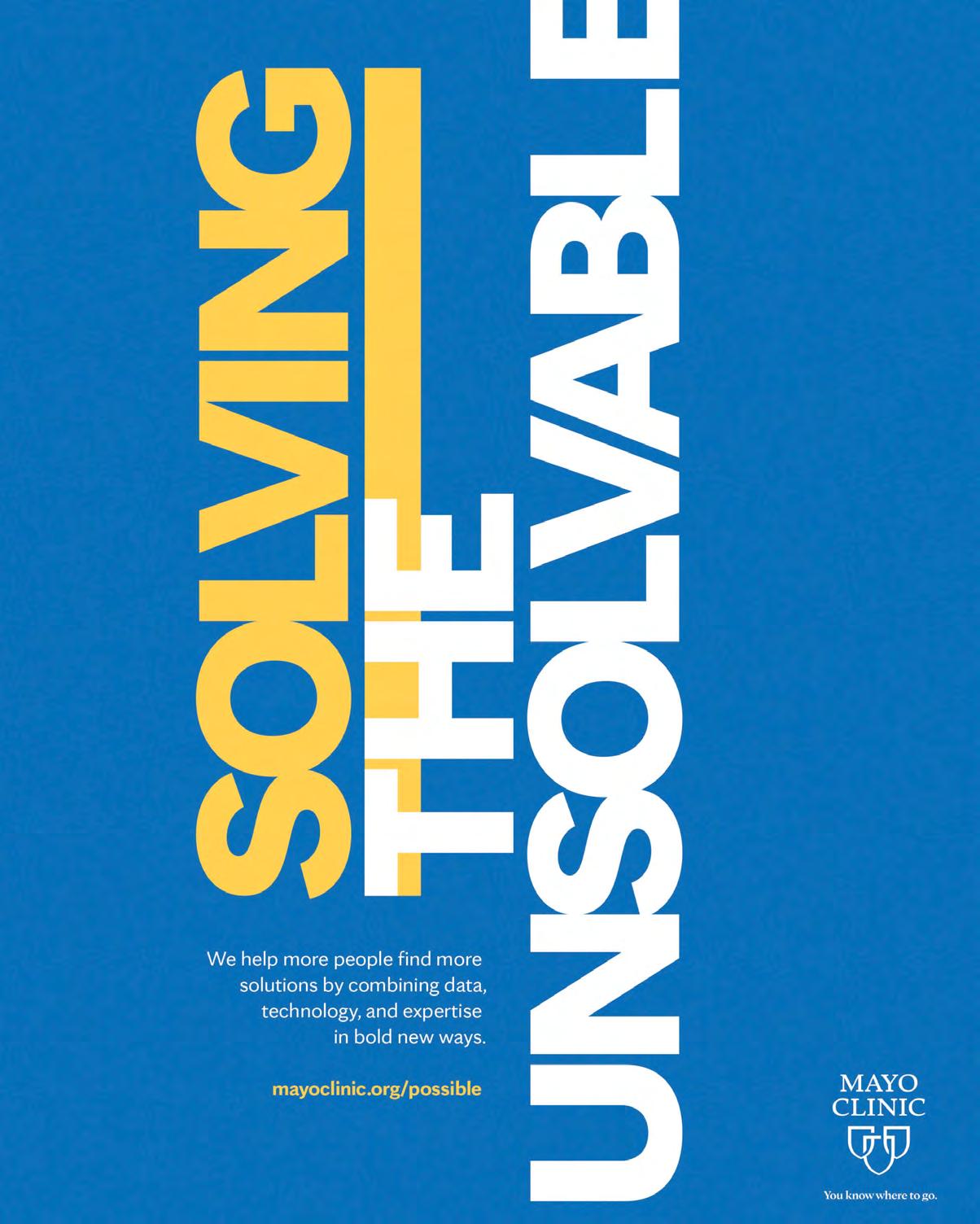

Arizona State University, ASU Thrive Magazine PO Box 875011, Tempe, AZ 85287-5011


























































 By the numbers #ASUgrad
By the numbers #ASUgrad
























































